Don Muang International Airport or the old Bangkok International Airport is one of the world’s oldest International airports and Asia’s oldest operating airport starting operations in March 1914 by the Royal Thai Air Force and commencing commercial operations in 1924. KLM Royal Dutch Airlines was the first airline to operate into the airport. Don Muang Airport closed in 2006 following the opening of the then new Suvarnabhumi Airport, before reopening in March 2007 after renovations. The airport is the main hub for Nok Air, Thai AirAsia, Thai Lion Air, and Orient Thai Airlines. Today the airport is divided by a large golf course right down the centre of the airport which is operated and cared for by the Royal Thai Air Force who also continue to operate form this base, with C-130 Hercules, HS-748 and the VIP aircraft all operated from here.
The museum it’s self was established in 1952 to collect, preserve and restore airframes and other aviation equipment used by the Royal Thai Air Force. The museum is set on a large area adjacent to the airport and a point to make is, it is on an active military base. The General public is able to access the museum however and at no charge There is a great museum shop and cafe where I admit to spending some of my hard earned there and then buying a bigger suitcase to bring it all home! Boasting some extremely rare exhibits including the only known example of a Corsair I, one of three Tachikawa’s, and even an example of a Curtis Hawk III.
With a collection showcasing the early days of the RTAF through to today’s modern marvels there is something for all interests.
This report is staged over 12 months. Some of the exhibits have been moved either indoors or shuffled around. I must also express my absolute thanks to the RTAF Museum in allowing me access to their collection and the guided tour.
Enjoy this walk around this world class museum and its exhibits.
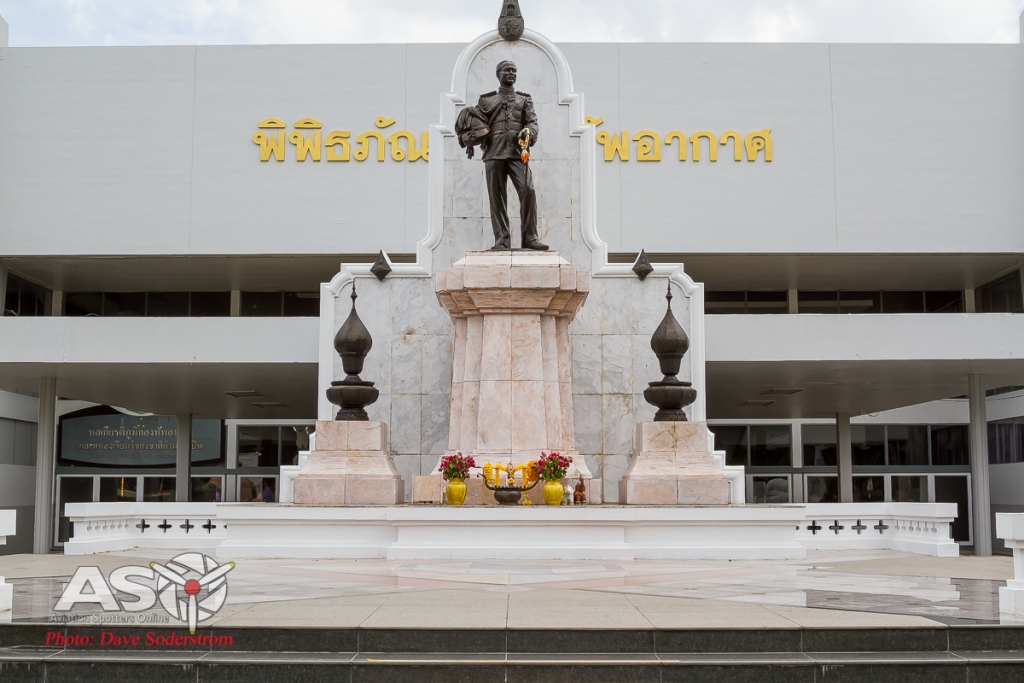
RTAF Museum entrance.
Northrop F-5 Freedom Fighter
The Northrop F-5 was developed as a lightweight for Nations to poor to afford the latest in fighter technology. The aircraft was a very successful design, its proved performance, and economics saw it widely exported. Thailand received their first F-5A’s in 1967 as part of an agreement with the United States and South Vietnam. The agreement saw Thai soldiers fight along side the South Vietnamese. The first deliveries of 30 aircraft were configured as ground attack airframes and for reconnaissance as RF-5A/B. In 1980 the F-5E of which 38 were delivered and F-5F were 6 were added joined the fleet. The aircraft have been progressively upgraded over the years and will continue to the anticipated retirement in 2030. There are three examples on display at the museum.
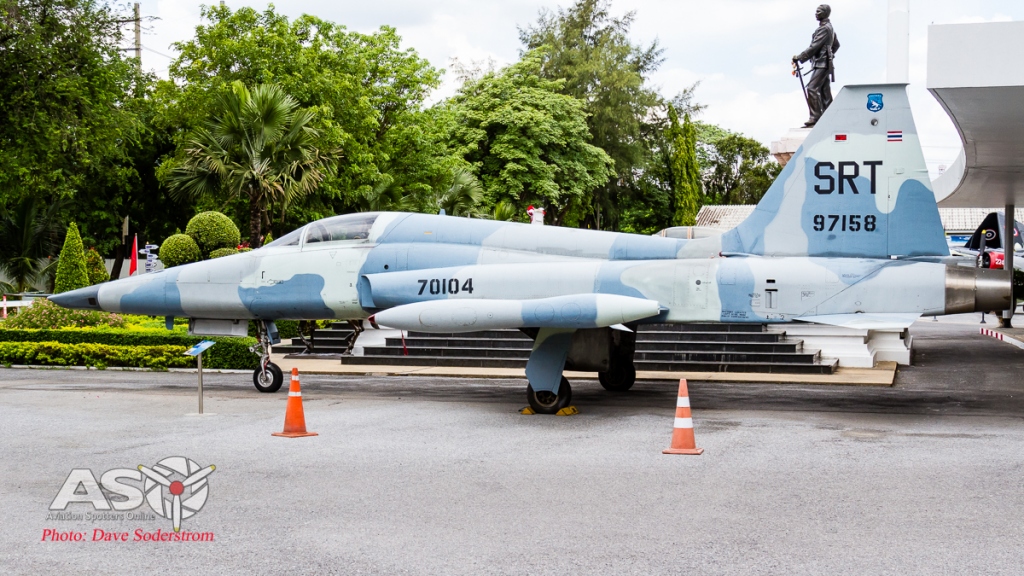
Northrop RF-5A Freedom Fighter, 69-158 70104 was formally operated by 701 Sqn, “Sharks” 7th Wing based at RTAFB Surat Thani. It was retired from service in October 2006.
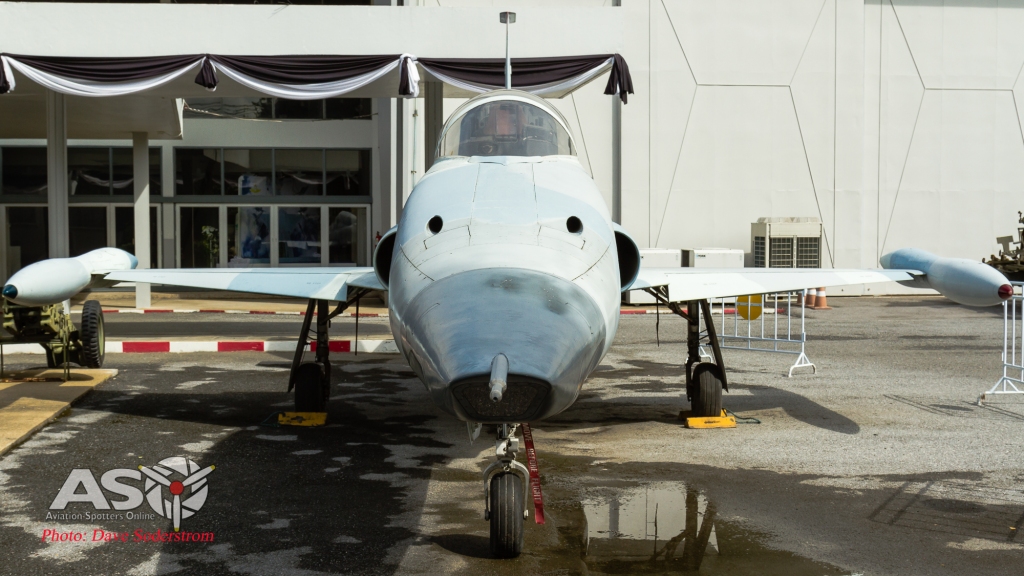
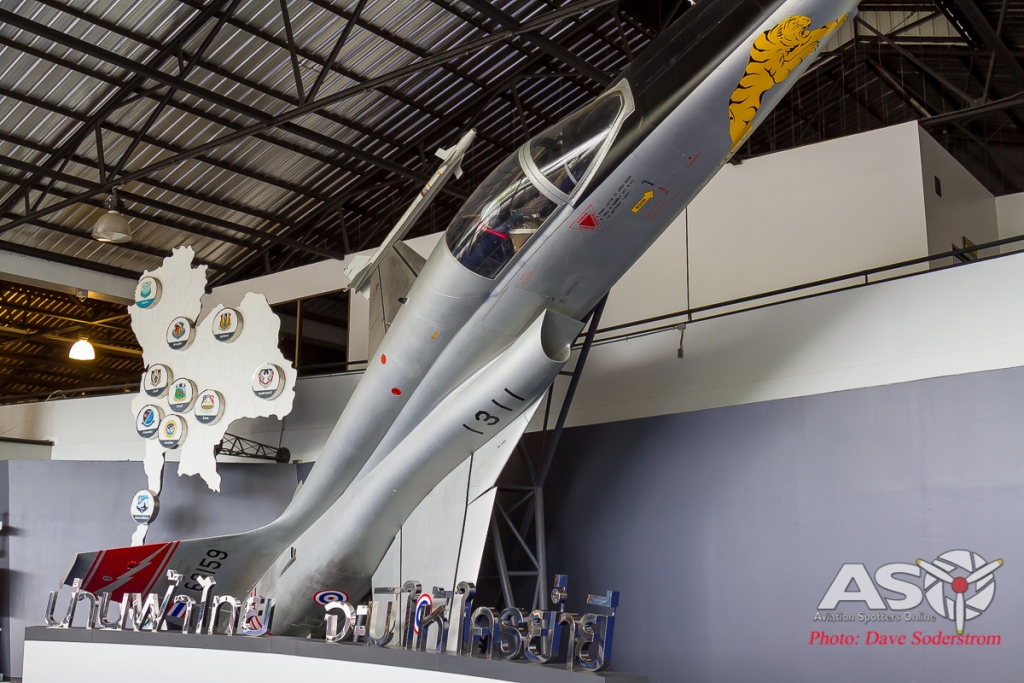
Northrop F-5A Freedom Fighter 1311, serial number ‘69159’. was operated by the RCAF as 1275. It is painted as an aircraft flown by 103 Sqn, 1st Wing, RTAFB Korat.
SIAI Marchetti SF-260 MT
The Marchetti SF-260 is a two seat trainer designed in Italy. It was also designed as a light attack aircraft. The RTAF purchased twelve initially and a further six in in 1978. The aircraft served from 1973 through to 1994.

RR.08-17 SIAI-Marchetti SF.260MT Royal Thai Air Force. The type replaced the North American T-6.
Pazmany PL-2
The Pazmany PL-1 Laminar and Pazmany PL-2 are American two-seat trainer and personal light aircraft designed by Ladislao Pazmany to be marketed as a home built aircraft by his company Pazmany Aircraft Corporation. Only one PL-2 was to see service in the RTAF. It was built as an engineering exercise designated Directorate of Aeronautical Engineering Model 1. It was in service from 1975-1989.
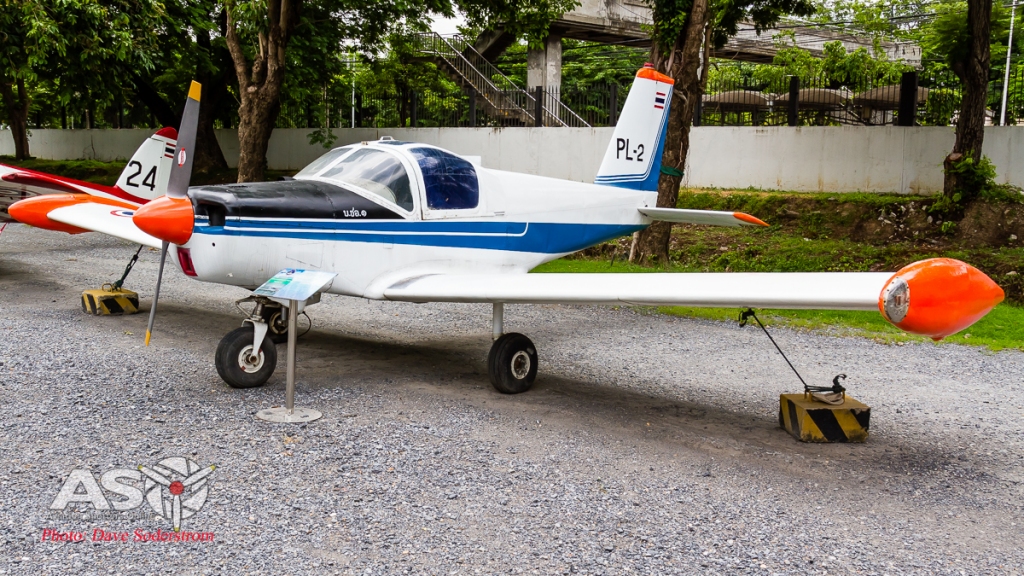
De Havilland DHC-1 Chipmunk.
Designed in Canada to suit a RCAF requirement for a training aircraft, Sixteen Chipmunks served with the RTAF over a fifty year period from 1948. Two are on display with the museum’s grounds. This example is a Chipmunk T.20, Serial no 24 which came to the museum in 2002.
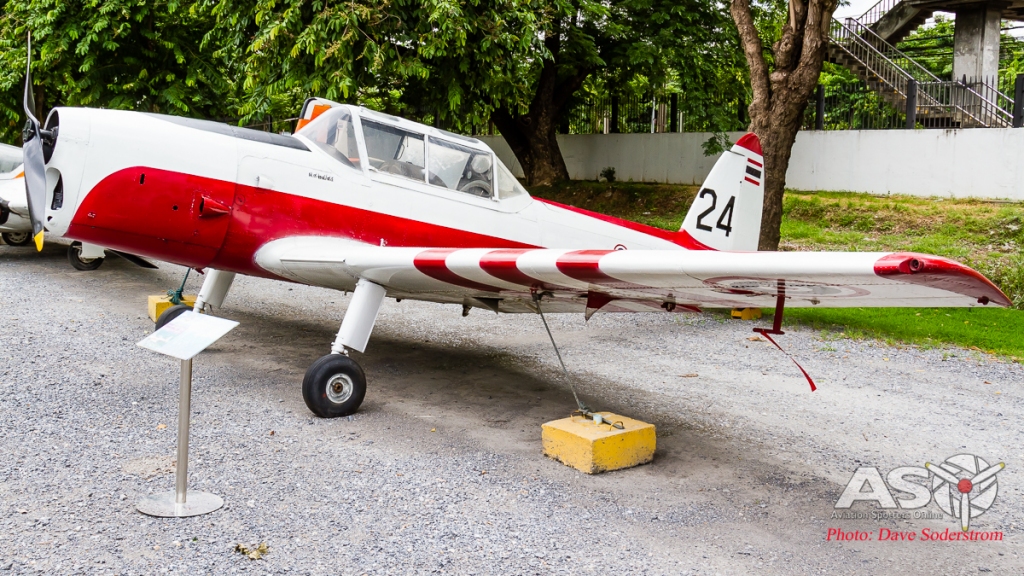
DHC-1 Chipmunk , number 24

Cessna T-37B ‘Tweet’
The Cessna T-37 Tweet was designed to a USAF requirement for an ‘all through’ jet trainer. The first prototype flew in 1954, 534 T-37As were built before production turned to the T-37B. Entering service with the RTAF in 1961, eight B models were received from the United States. Fourteen more T-37Cs were later acquired. The T-37 where used by the FTS in RTAFB Khampaeng Saen, the type was retired from service in 1996.
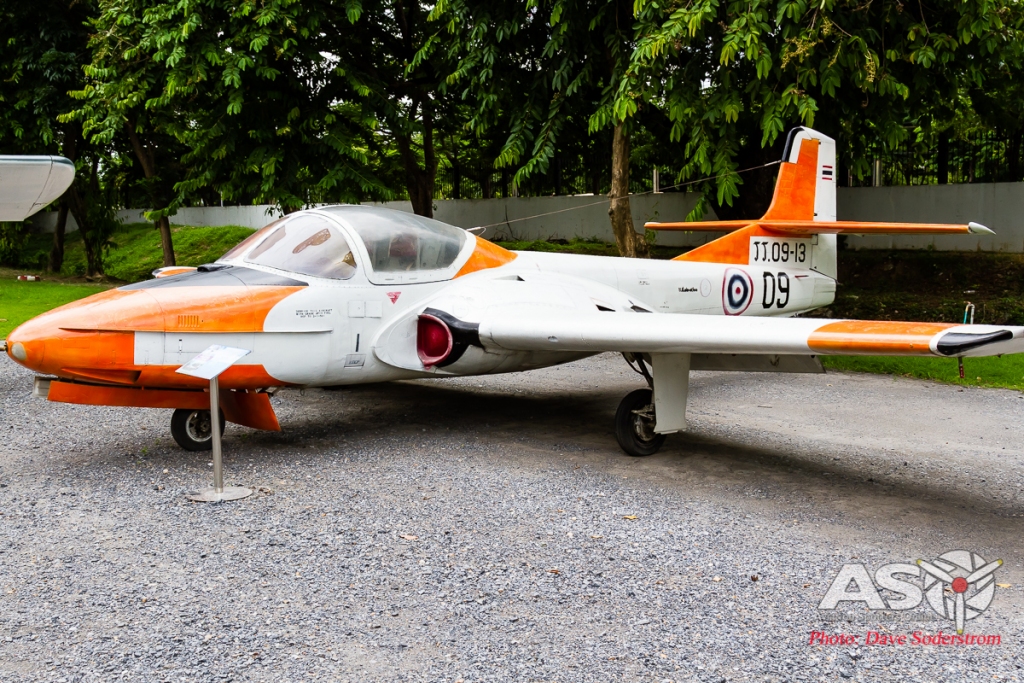
Cessna T-37B, BF.12-09/13 served at FTS, RTAFB Khampaeng Saen from 1970-1996.
RFB Fantrainer 400

Helio U-10B
This aircraft is a short take-off and landing utility and observation aircraft, used in Thailand from 1961 until 1995. Serial 7135
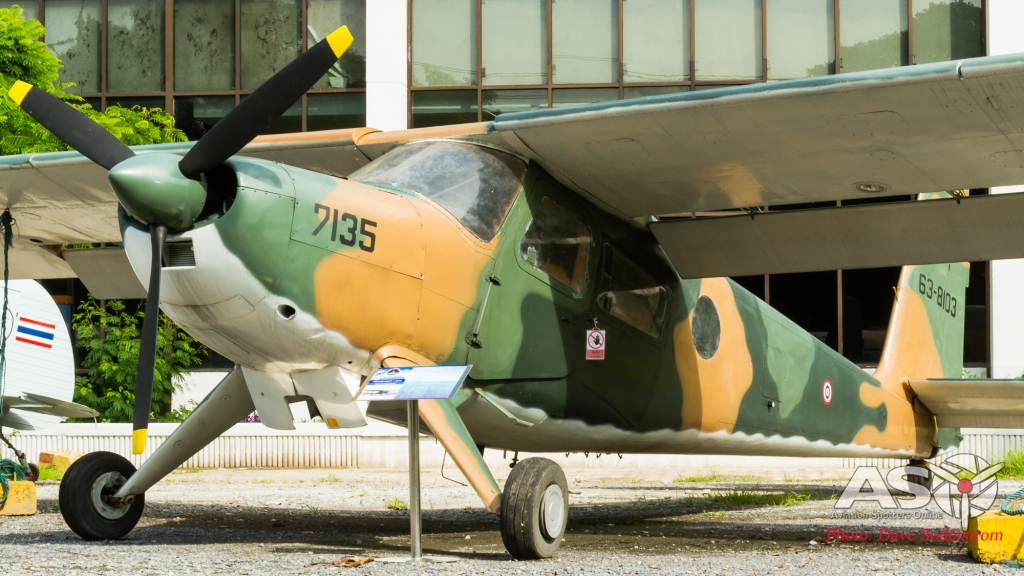

Cessna A-37 Dragonfly.
The A-37 Dragonfly is a side-by-side two seat jet light attack aircraft. It was developed from the Cessna T-37B trainer for COIN (counter insurgency) operations. The development including replacing the original engines with engines of more than twice the power and adding under-wing hard-points for carrying a wide variety of weapons. 537 of these aircraft were built. A number were purchased from the USA by the RTAF, more were added from abandoned aircraft by the Vietnam Air Force at the end of the Vietnam war. Approximately thirty of these aircraft served from 1972 and were retired from service by 1993.

North American T-28 Trojan
The North American T-28 Trojan joined the RTAF in 1962 and retired in 1988. Some 120 aircraft were to come from the USAF. This particular airframe is ex Bu137661, and joined the collection 1988. it is a T-28D-10 Version. Several Squadrons operated the type and these included, 221 Squadron at Chiang Mai, 222 Squadron at Ubon Ratchathani, 223 Squadron at Udorn, and 224 Squadron at Koke Kratiem. Of particular note are the under wing machine gun pods and the hard points which was a notable feature the trainer versions didn’t have.


Lockheed RT-33A Shooting Star
The Lockheed RT-33A is the reconnaissance version of the F-80 Shooting Star. The Shooting Star is the most successful jet trainer in history with over 6000 built. The RT-33 is a single seat version of the T-33 with the sensors located in the nose of the aircraft. The RTAF operated both the T-33A and RT-33A, with 46 and 8 operated respectively. operated between 1955 through to 1996. One of two on display at the museum.
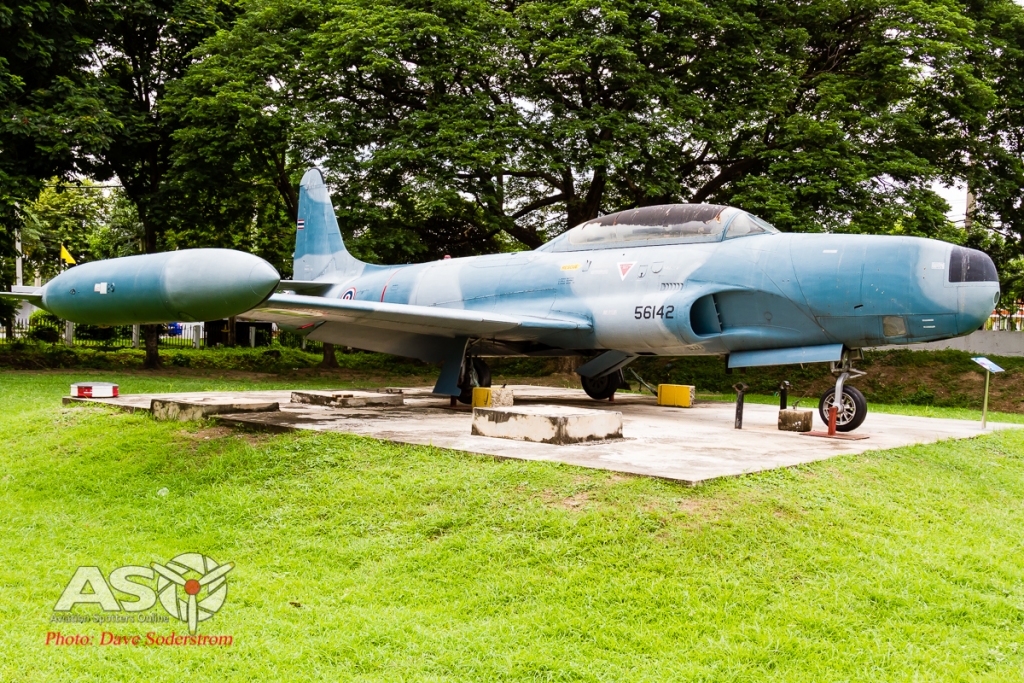
North American T-6 Texan
The standard advanced trainer for the US Army Air Force the Texan or Harvard to the Commonwealth countries. After initial flight training on a basic aircraft, trainees would move on to the T-6 to learn the vagrancy’s of retractable undercarriage, variable-pitch propeller and other advanced equipment. 138 of these aircraft were delivered to Thailand, where they were in service from 1948 to 1981. One of two examples on display.
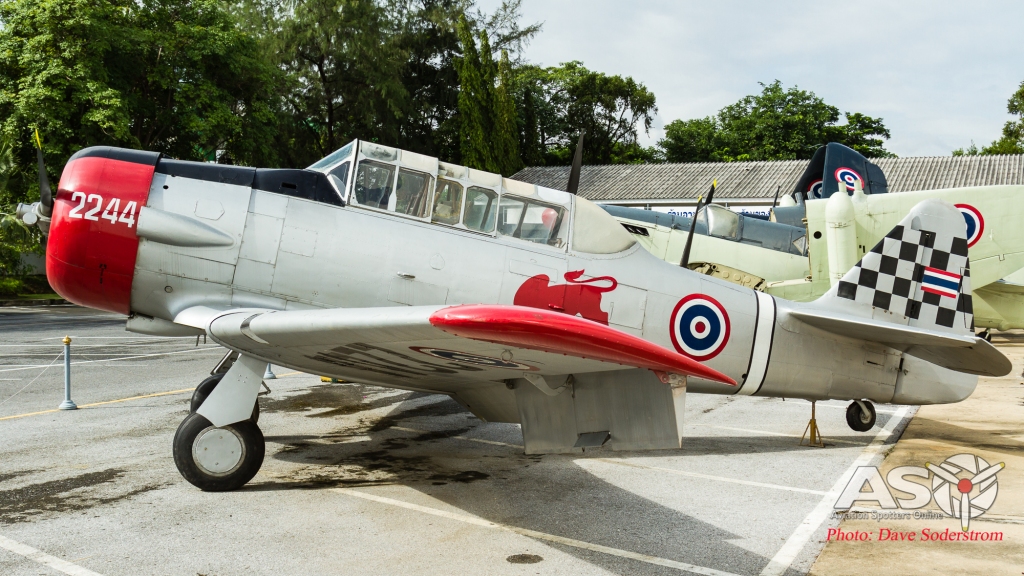
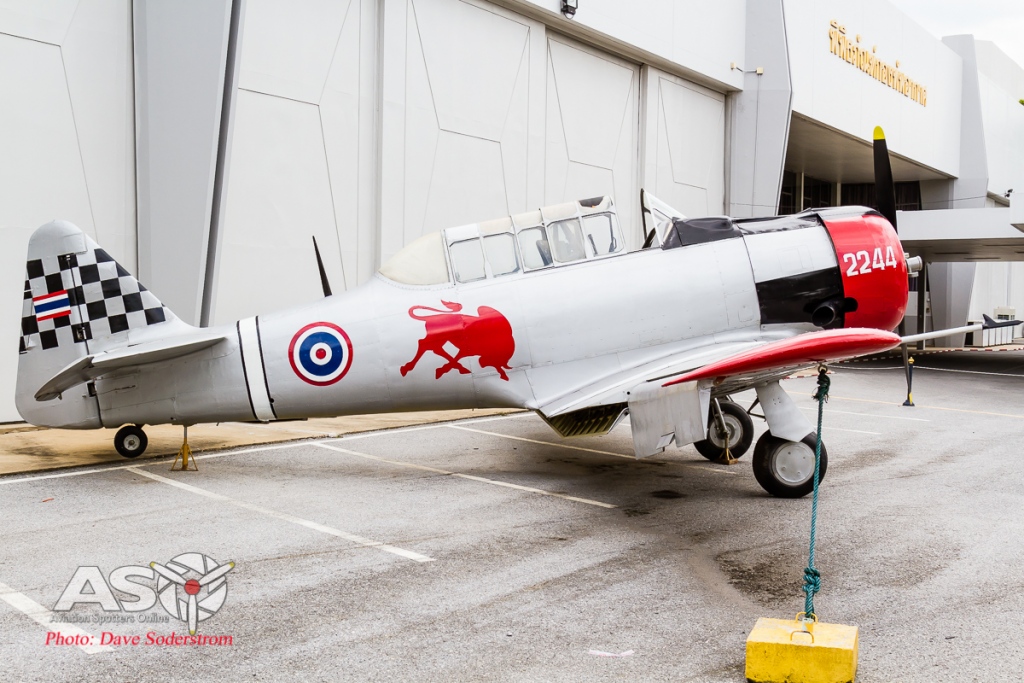
T-6F ex 44-81796
Fairey Firefly.
This British, Rolls Royce Griffon engine powered is carrier-based aircraft. Operated in the fighter-bomber and reconnaissance roles. The early variants were distinguished by the under nose radiator. Later versions saw these located into the wings thus changing the profile of the aircraft considerably. The Thai Air Force took delivery of ten Mk.1 aircraft plus two Firefly T.2 trainers which served from 1951 to 1959. This aircraft c/n F.7402, is ex British Fleet Air Arm MB410.

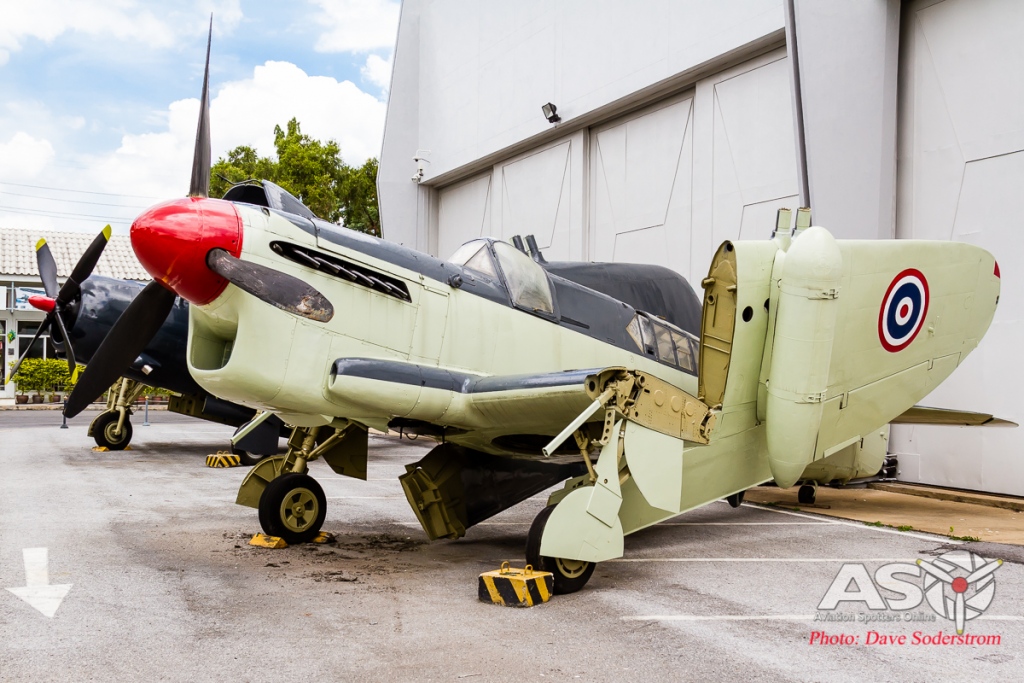
Curtiss SB2C Helldiver.
This two or three seat (depending on version) carrier borne aircraft first went into service with the United States Navy in 1942. Powered by a Wright R-2600 Cyclone engine delivering some 1900hp. The Royal Thai Air Force took six of the type into service in 1951, their service life was very short retiring in 1955. This is the only survivor, one of two complete examples on display anywhere in the world. It’s US Navy identity is Bu83410.

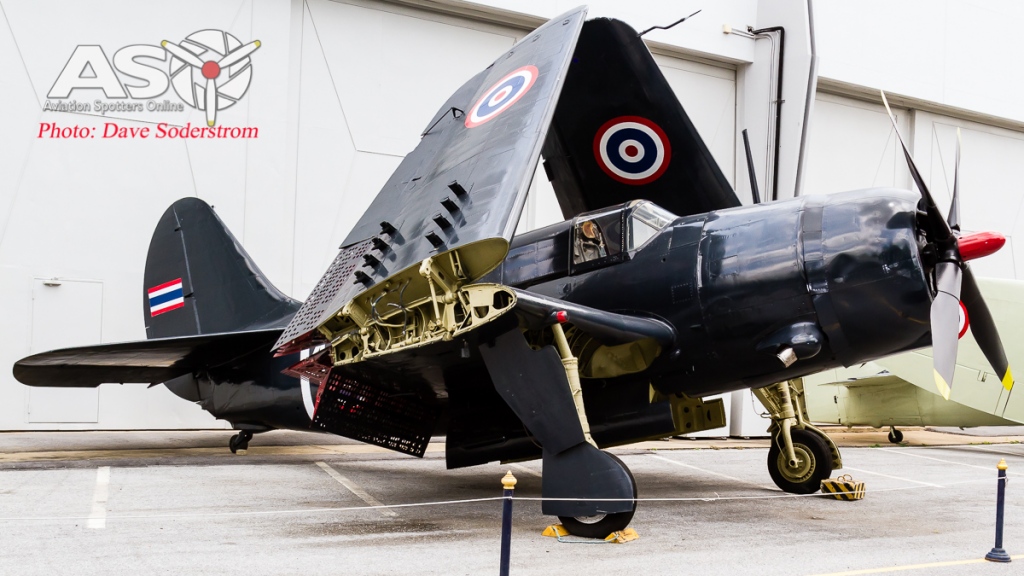

Upon entering the main halls sits some fantastic displays of models, pictures and story boards. One that I personally really liked was this one showing all the types flown by the RTAF.
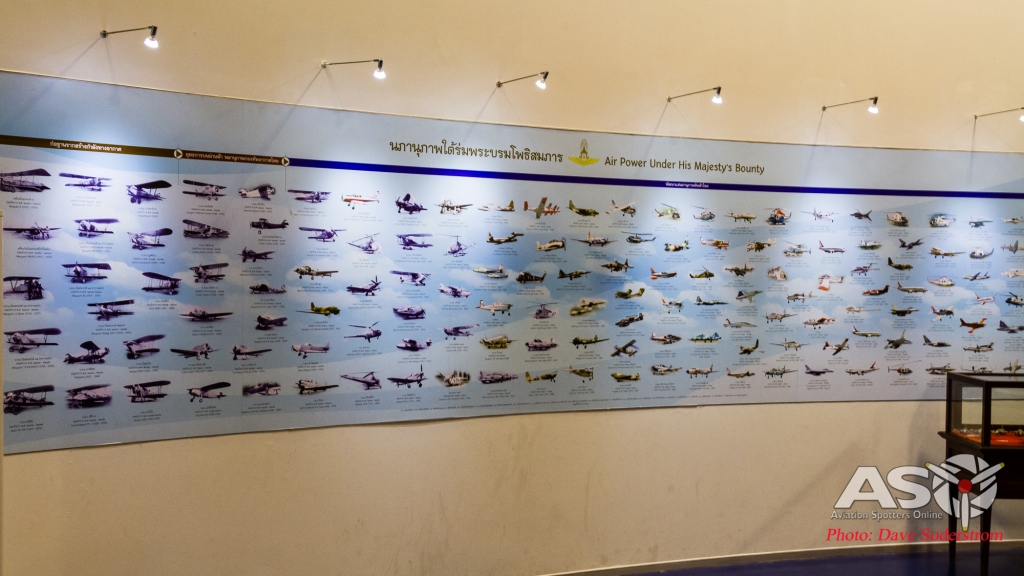
Nieuport IIN / IVG
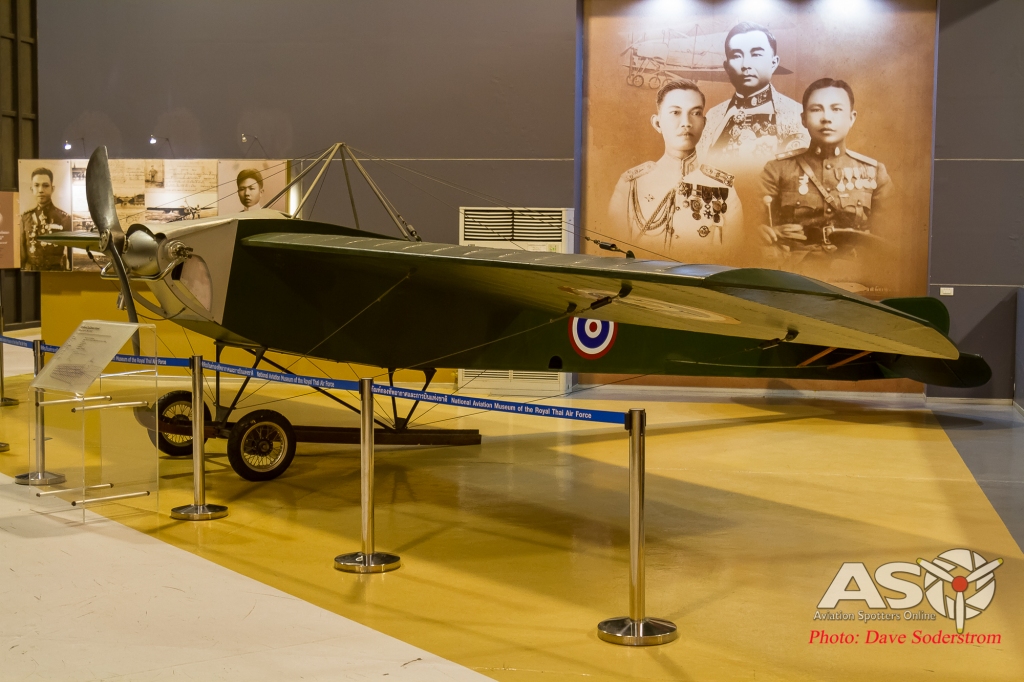
Breguet Type III

Breguet III Replica
Vought V-93S Corsair
This was the export version of the Vought O3U, US Navy aircraft that was built during the early 1930s. Twelve of these were sold to the RTAF in 1934 following purchases of the Vought V-65 and V-92 versions. They remained in service until 1945. This is the only survivor anywhere in the world. Making it an exceedingly special display and a national treasure.


Curtis Hawk III
The Curtis Hawk III is another early design at the museum. Twenty four were shipped to Thailand from 1935 through to 1936. Local production started in 1938 with first batch of 25 completed in 1940 a second batch of 25 started 1939, but not all believed completed. The type was retired from RTAF service in 1949. This example is the only survivor of the type and is the sole survivor extant in the world.

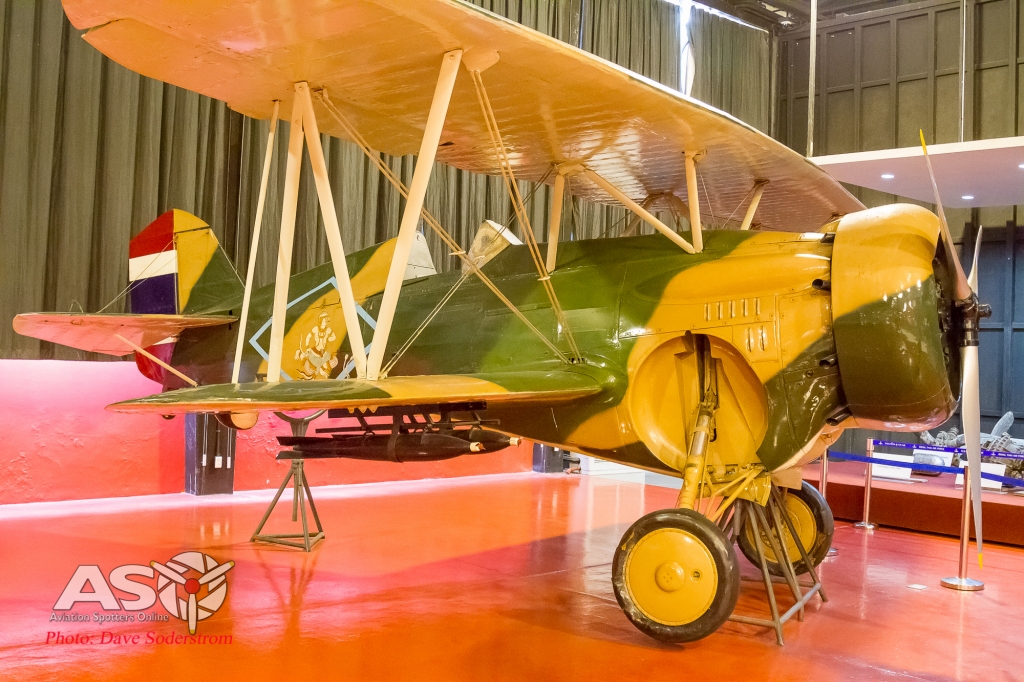
Grumman F8F Bearcat.
The last of the great piston-engine fighters from The Grumman Aircraft Corp., the Bearcat design featured folding wings for service as a carrier-based fighter with the US Navy. Too late to see active service in World War 2, about 1250 examples were built in the mid-1940s. The Bearcat is powered by a Pratt & Whitney R-2800 radial engine producing 2100hp, and was used by the RTAF from 1951. The RTAF used both the F8F-1B and -1D models, with about 150 aircraft in use up until 1963. The Museum’s Bearcat is serial 15-178/98, and carries the code 4312.
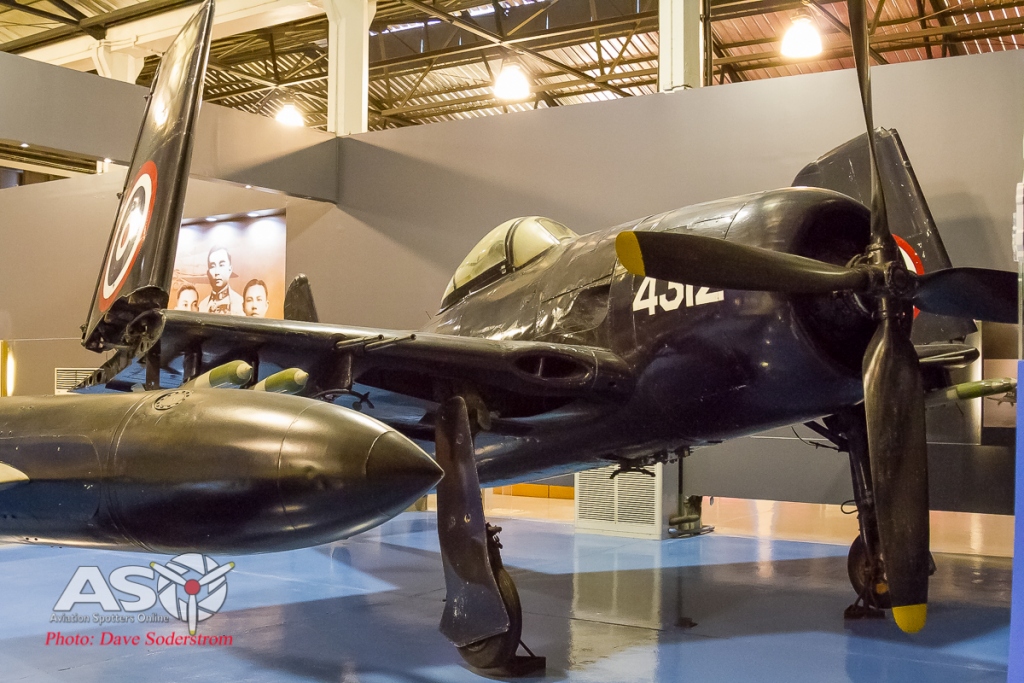
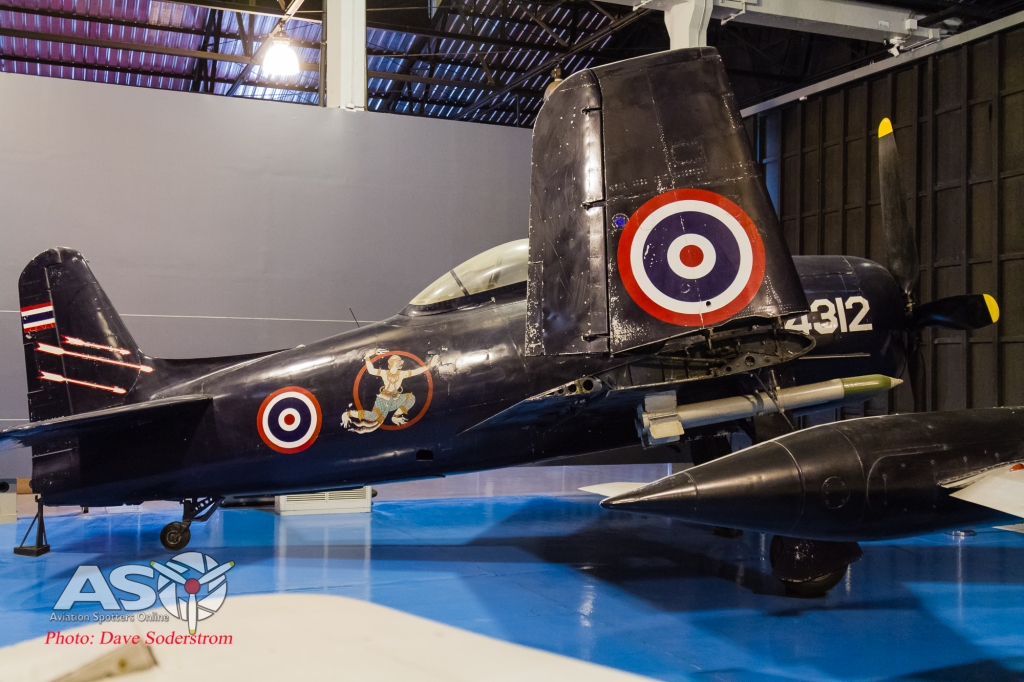
Lockheed T-33A Shooting Star
The second Shooting Star on permanent display with the museum’s grounds. As mentioned previously 46 of this version were flown by the RTAF. Aircraft 1132 joined the museum collection in 2000 and sits proudly on display within the main hall display.
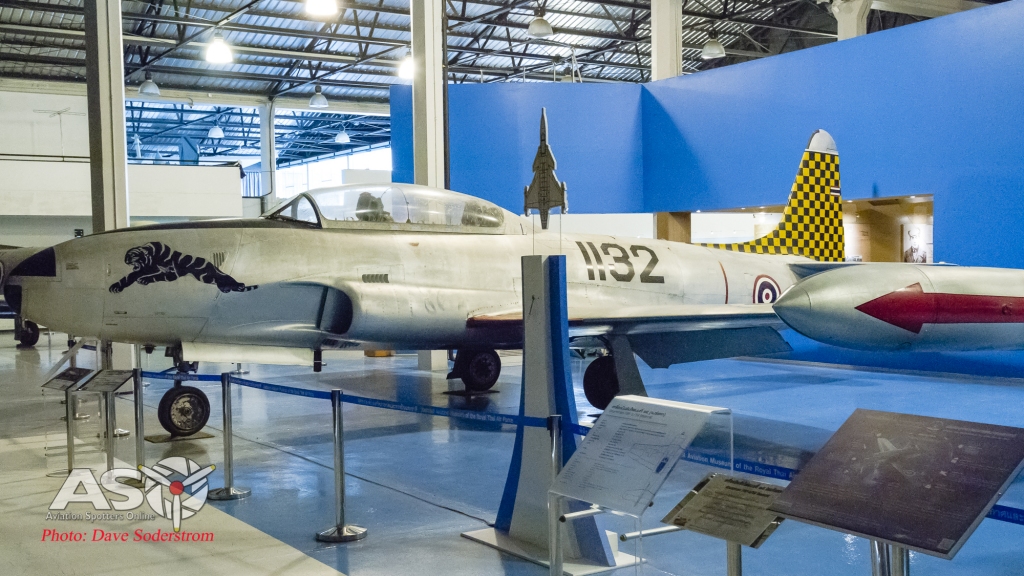
North American F-86 Sabre
The North American F-86 Sabre was designed using captured German swept wing research after World War Two. The prototype first flew in 1947. The Sabre brought the USAF into the Jet Age, even taking the World Speed Record on 1948 by reaching 671 it wasn’t long before the jet was put to use in the Korean War. Pitted against Soviet Mig-15s the Sabre was better in that it could fly higher and was better armed with six 12.7mm guns. The Thai Air Force took over 60 Sabre into service in the F-86F and F-86L versions. They were in service from 1958 to the 1970’s.
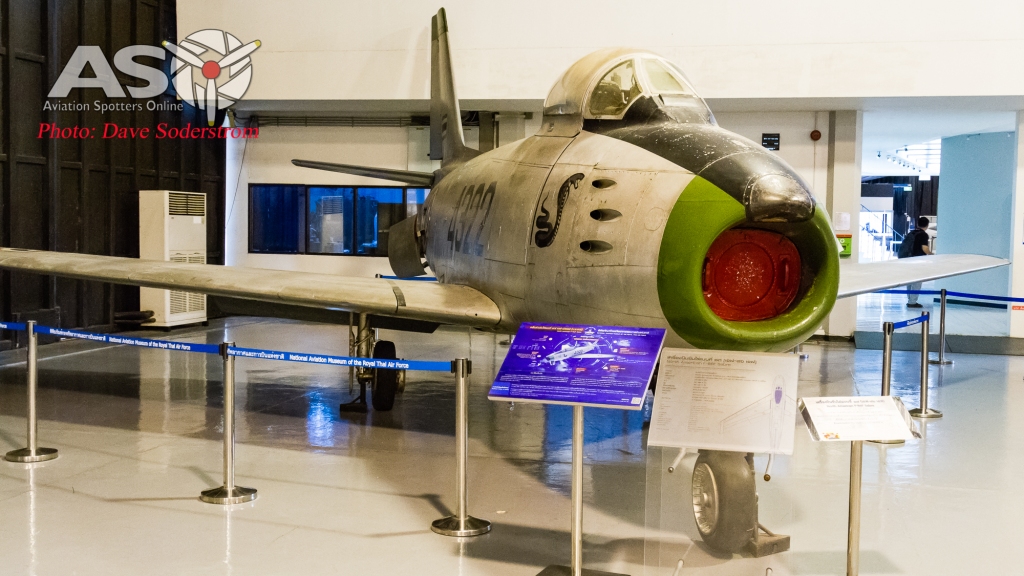
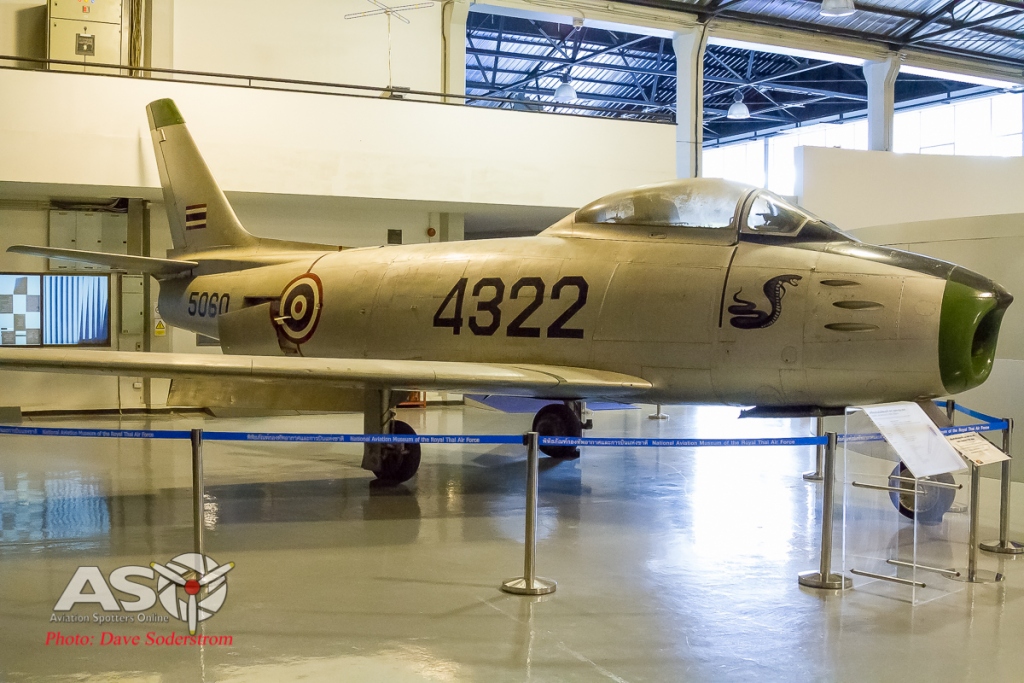
Northrop F-5 Freedom Fighter.
The single seat F-5 first flew in May 1963, entering USAF service the following year. Developed from the N-156 Fang proposal for the United States requirement for a light weight fighter, it also spawned the T-38 Trainer. Powered by two General Electric J-85 after burning turbojets the F-5 was is known for being the able to carry reasonable mission load outs yet maintain reasonable to operate. Serving with many air forces around the world it is estimated some 200-300 remain in service around the world. Thailand first ordered 30 F-5A/B/C models now retired. The current F-5 fleet, which were upgraded to F-5T Tigris and F-5F in 211st Sq. will continue to serve to 2025–2030. Two F-5s are on display within the hall, F-5B 70101 and F-5A 70143.
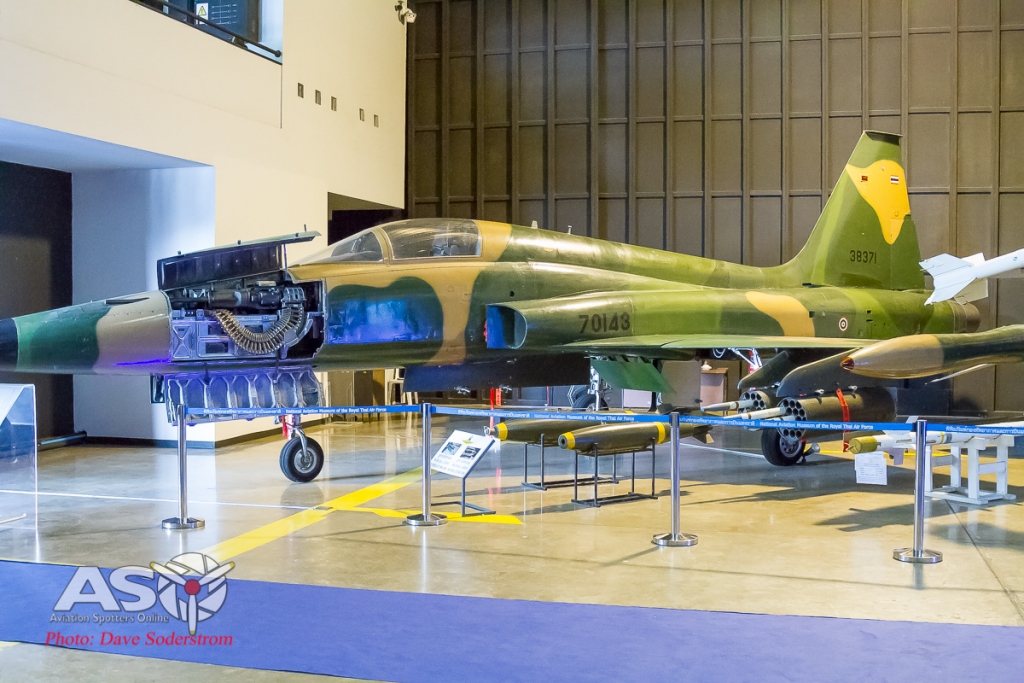
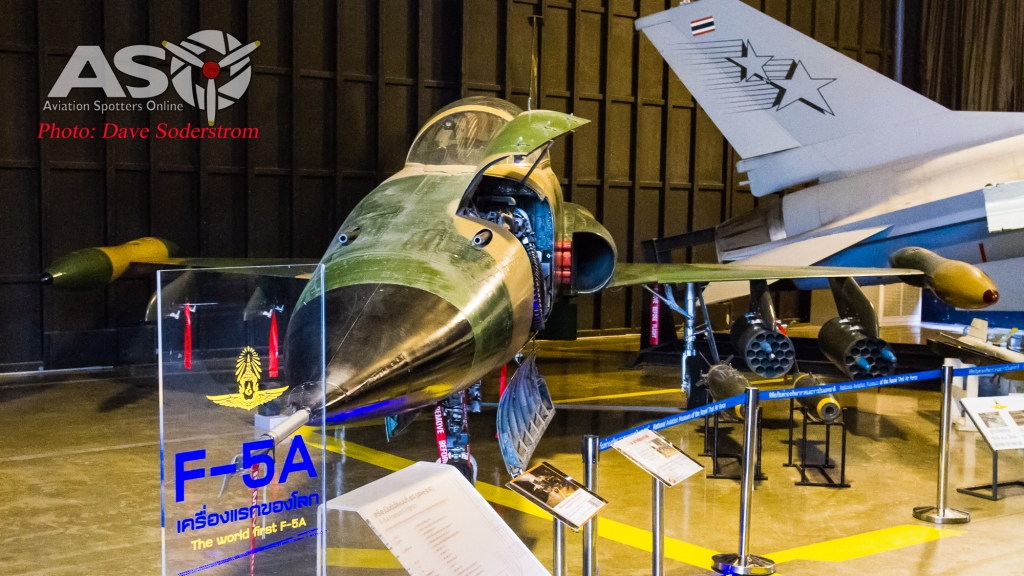
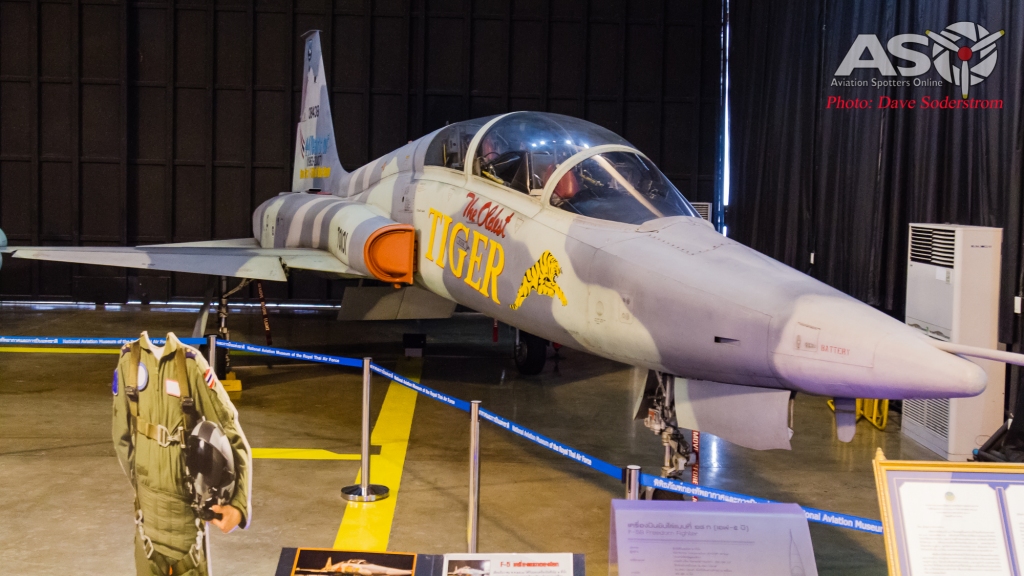
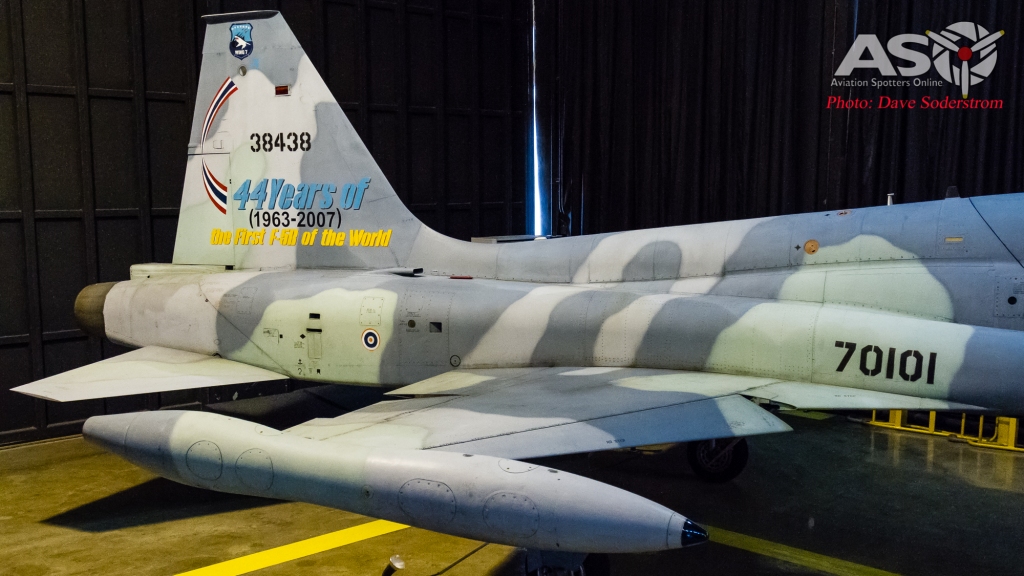
This F-5B wears these unique and special markings, firstly celebrating the 44 years of operations of the early versions of the jet. It also proudly wears the markings noting it as the oldest F-5B in the world! Quite a unique aircraft, on a personal note I think the F-5 is one very slick looking jet!
General Dynamics/Lockheed Martin F-16A
The F-16 was born out of USAF requirement for a light weight fighter. The first YF-16 flew in 1974 with production standard aircraft flying in 1978. It was the first production aircraft fitted with a fly by wire system, thus making it more stable in flight. The F-16 is flown by many nations across the world. The Royal Thai Air Force has ordered a total of 54 F-16A/B Fighting Falcon aircraft. It received a further 7 F-16A/B aircraft as a donation from Singapore in exchange for the use of training facilities in Thailand by the RSAF. Aircraft 10200 (79-0324) is on display in the modern jet hall.
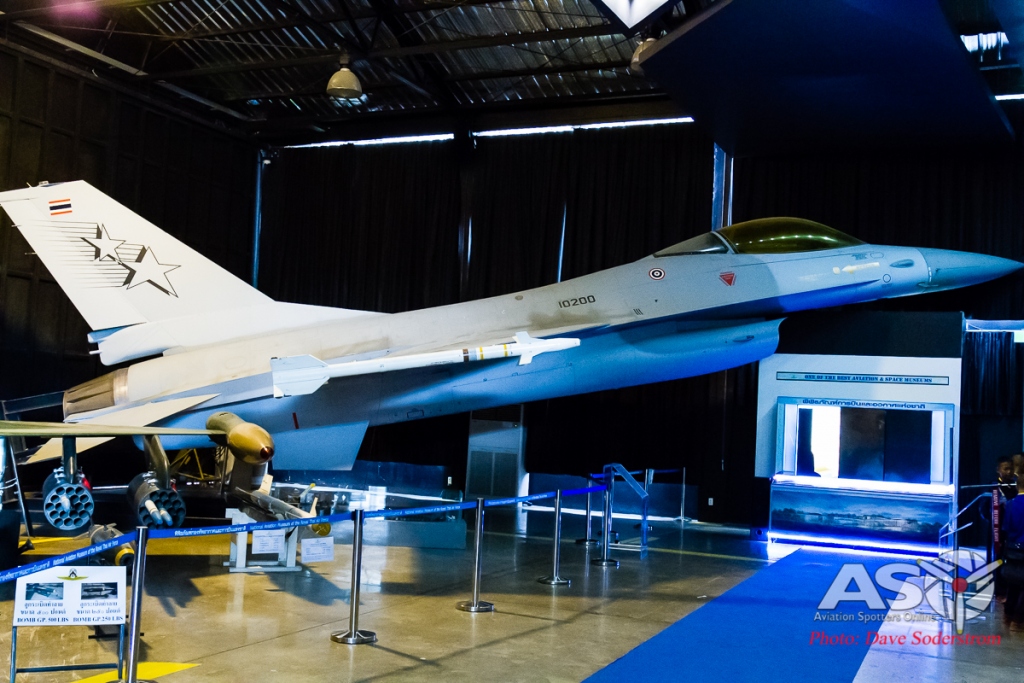
SAAB JAS-39C/D Gripen
Twelve of the SAAB JAS-39C/D models were ordered in 2008 to replace the elderly F-5s. Eight of the single seat C model and 4 of the twin seat D models are flown with 701 Fighter Squadron based at Surat Thani Air Force base. The aircraft on display a JAS-39A model was never flown in Thai service, it was a donation by the Swedish Air Force. It carries dual Thai and Swedish markings, 70100 on the port side RTAF scheme. With 39178 / ‘178’ on the starboard, Swedish scheme.
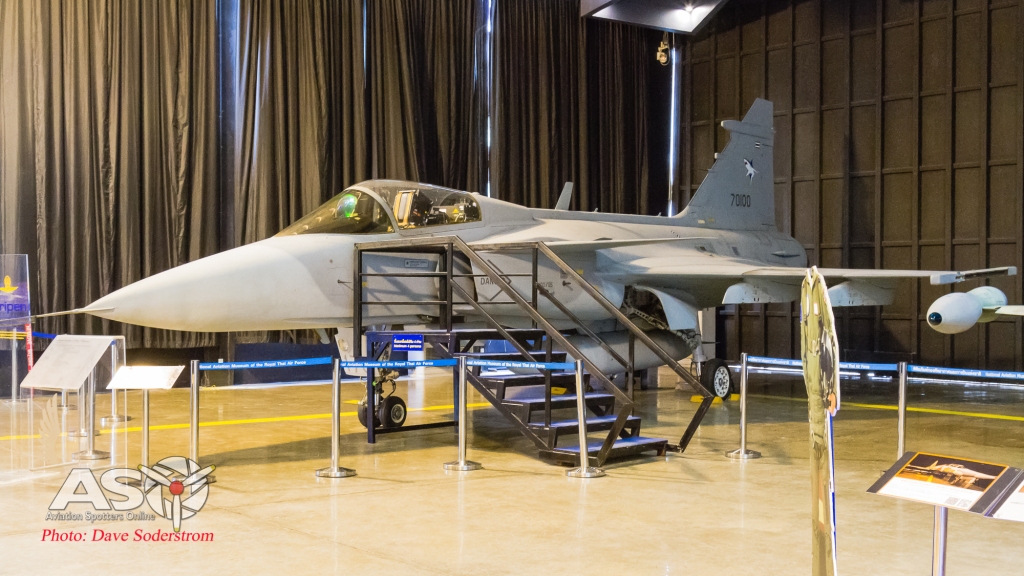
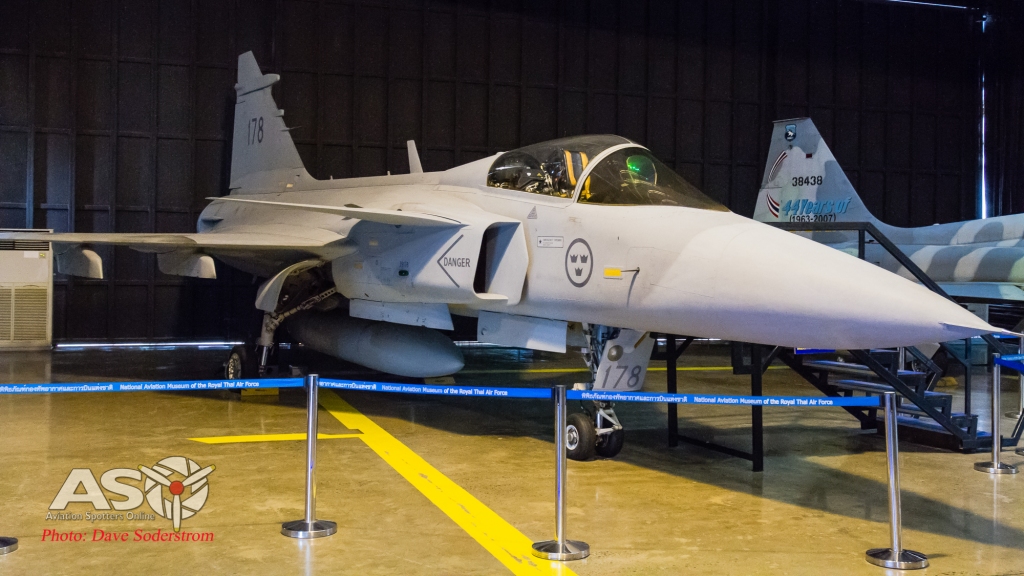
Display Hall Overview

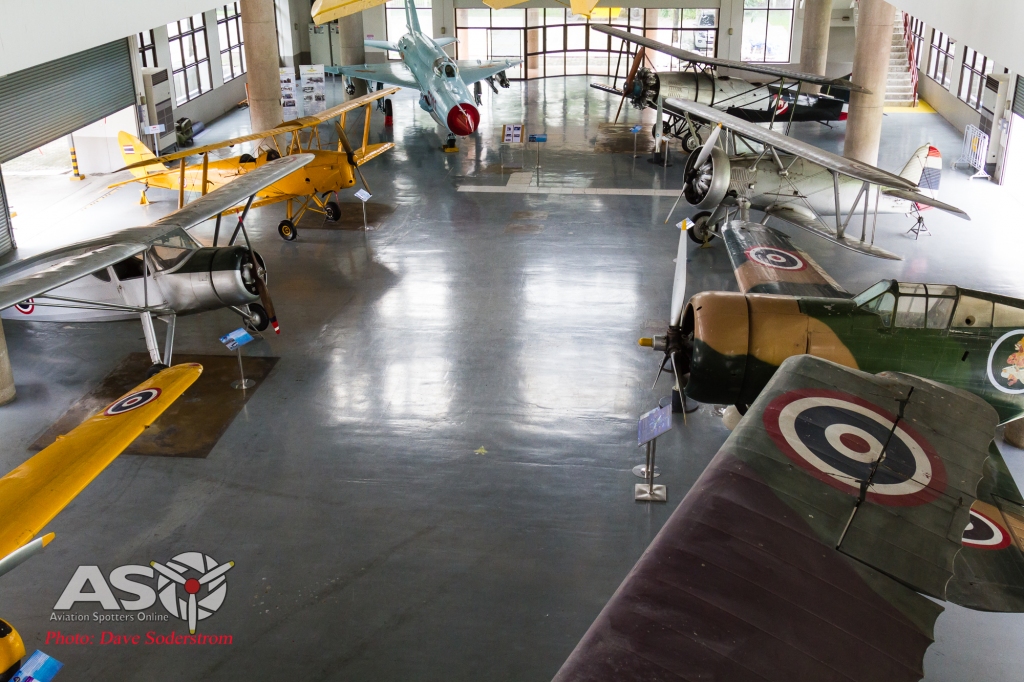
De Havilland DH.82A Tiger Moth
The Tiger Moth is a basic trainer designed in Great Britain first flying in prototype form in 1931. 8796 were produced in total and in countries like Canada, New Zealand, Norway, and Australia contributed by building 1070. The RTAF operated 31 in total between 1951 through to 1961.
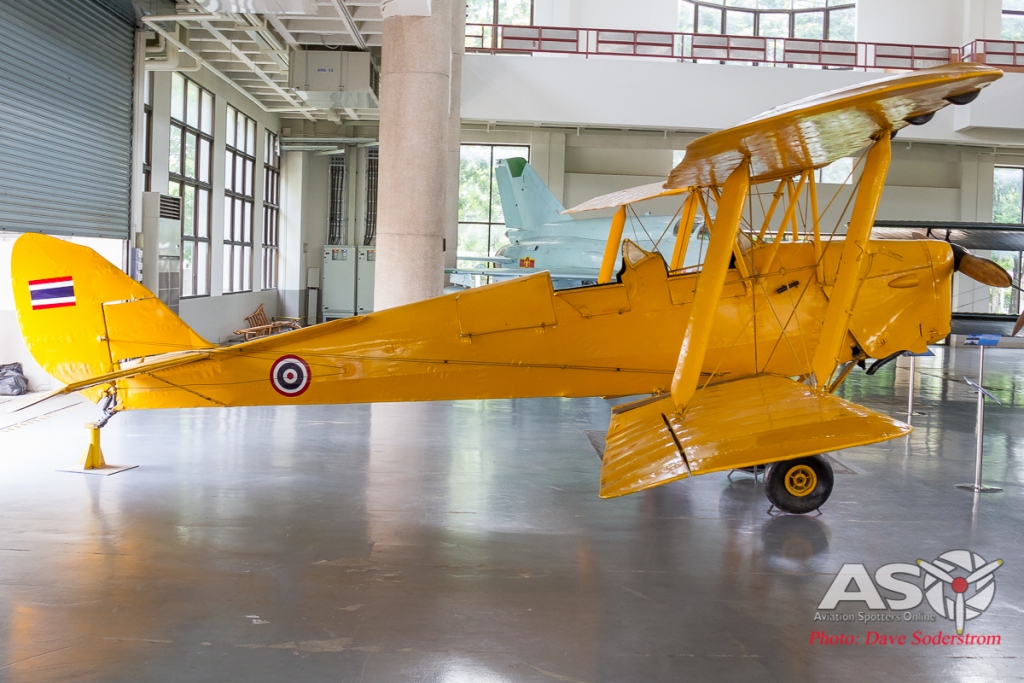
DH-82A Tiger Moth, said to be G-AMGB, c/n 82794, at one time coded ’21

Fairchild F-24
Fourteen Fairchild F-24’s were delivered to the RTAF from 1938. Used in the light transport and communication role the type continued to serve until being withdrawn in 1950. The aircraft on display has no notable serial number thus making hard to determine which airframe it is.


Mikoyan Mig-21.
The Mig-21 has some real credit to its name, more than 11,000 have been built and has fought in more wars than any other fighter produced. The Mig-21 codename ‘Fished’ by NATO is a lightweight day interceptor. The prototype first flew in 1955.
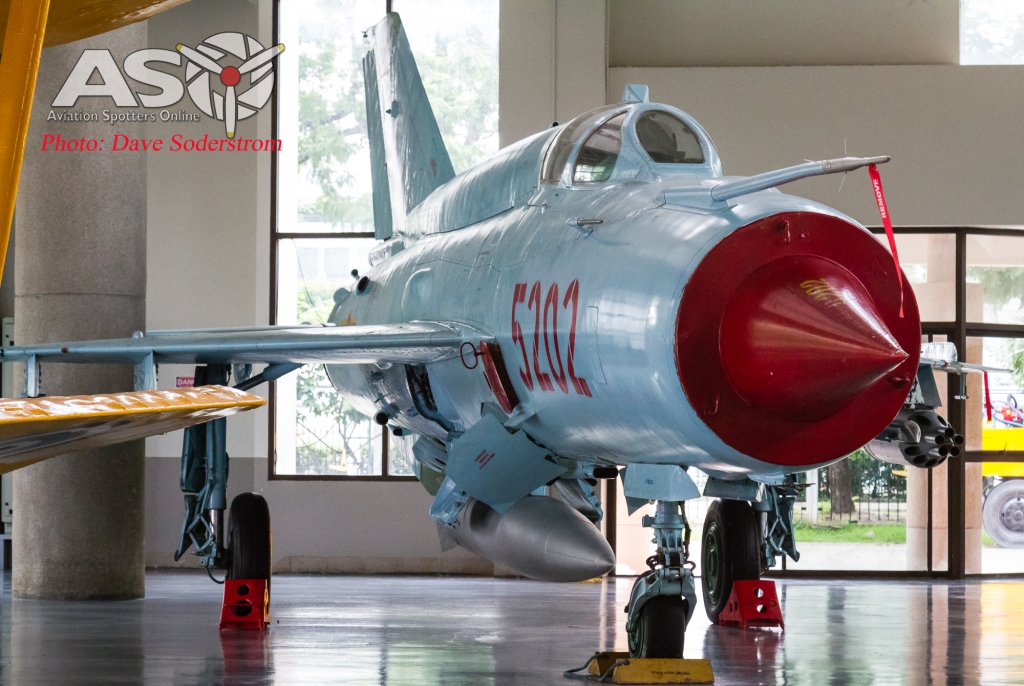
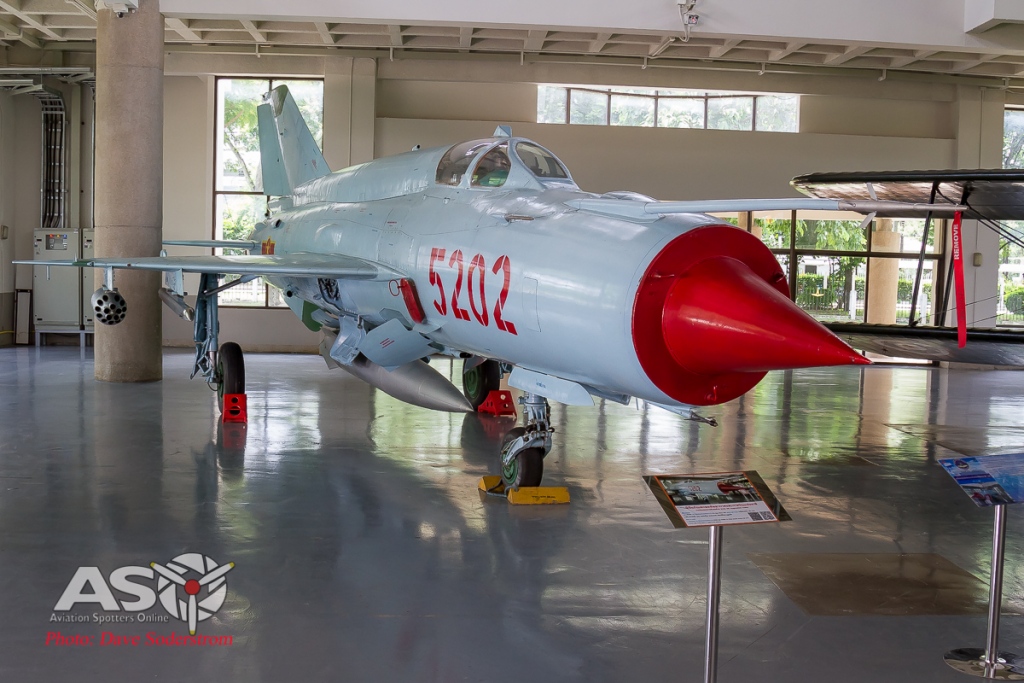
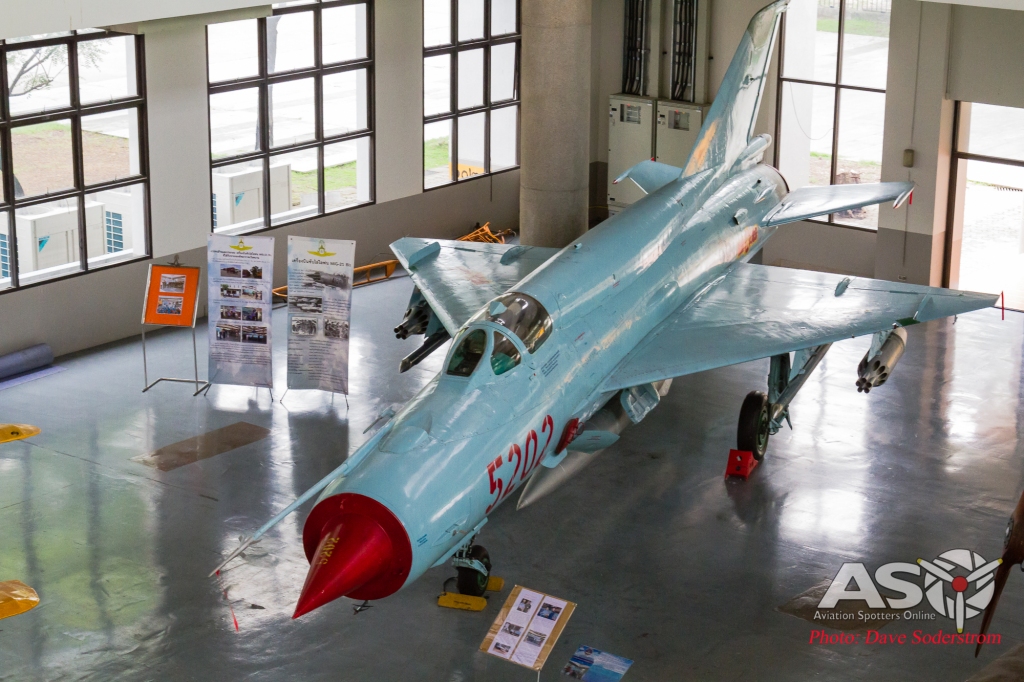
The aircraft on display was a gift from the Vietnam People’s Air Force. 5202 c/n 75069108 is a Mig-21Bis and joined the collection in 2014.
Boeing 100.
Yet another early type on display is a Boeing 1ooE. Two were delivered in 1931, for a comparison fly off between the Bristol Bulldog & Heinkel He43. Both were still active as late as 1941. Finally retired in 1949, this example was retained and survives at the museum.


Boripatra
The Boripatra was a locally produced design first flying in 1927. They were built by the Aeronautical Service Workshops at Don Muang. The replica on display is one of two found on the museum grounds. The Boripara is a standard mid-1920s design, with an un-cowled Bristol Aspid radial engine mounted in front of a rugged circular fuselage. Fewer than 12 of these light bombers were built up until their retirement in 1933.
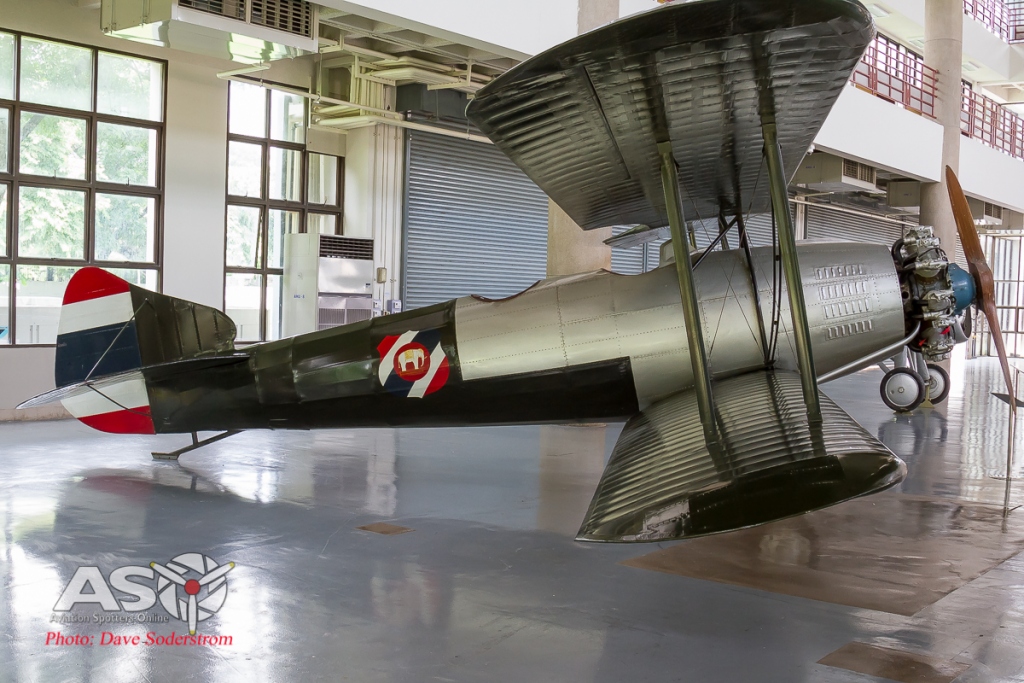
Curtiss Hawk 75
This absolute gem is another rare type in the world. The Curtiss Hawk 75N. Twelve were shipped to Thailand in 1938. The type was intended for local production however wartime activities ended these plans. The type continued to fly in RTAF service until 1949. This is one of five surviving Hawk fighters in the world.



Breguet 14P replica
Five of the French designed and built Breguet 14s flew with the RTAF with the type entering service in 1919. The aircraft on display is a flying replica built using a T-6 Harvard frame as a starting point. Built 1979 by Roland Payen for Salis Aviationex F-AZBH used in French TV series “L’aéropostale, Courier du Ciel” It was fitted with a Hispano 12X engine. swapped to RTAFM in exchange for Bearcat Bu122095 (Kh15-43/94), which went to La Ferté-Alais in 1987.

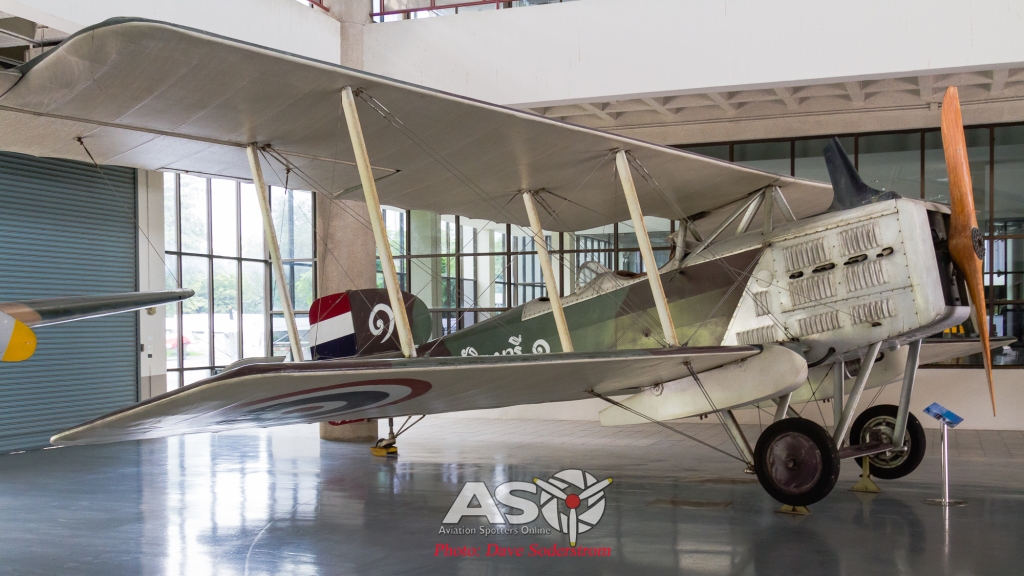

Republic F-84G Thunderstreak
The F-84G on display coded 1231 and 878 was one of thirty one aircraft in use from 1956 and in use until 1970. Thirteen came from European air forces including France and Belgium. They were refurbished by OGMA at Alverca, then shipped to Kisarazu Japan. A further eighteen came directly from the USAF, these were also refurbished by Kawasaki at Kisarazu. They were operated by 12 & 43 Squadrons.
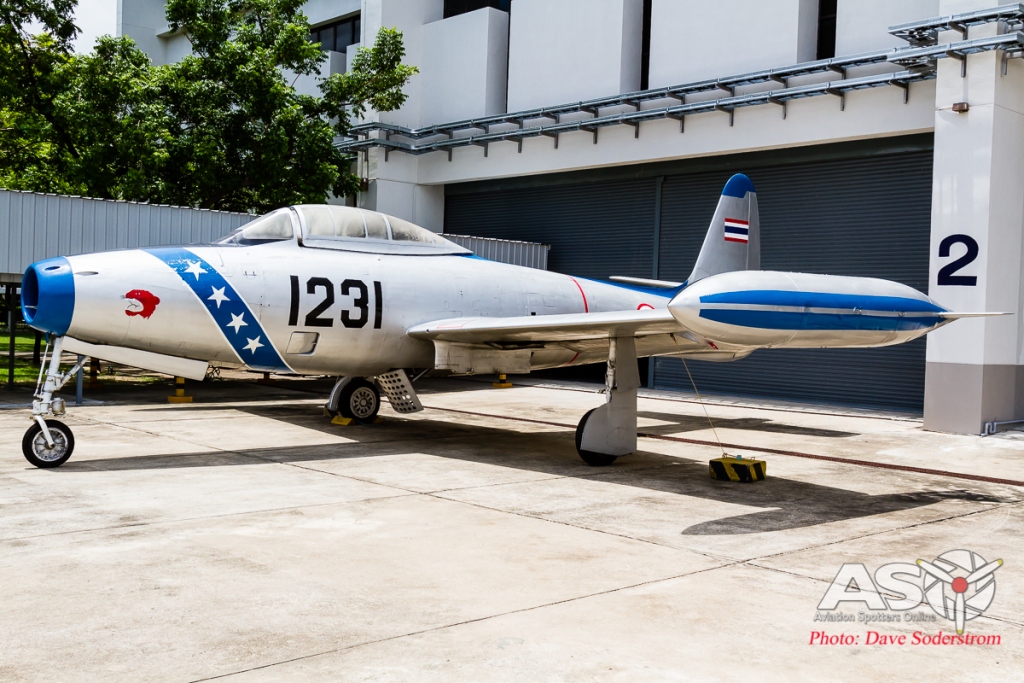
North American F-86L Sabre
In addition to the F-86F version, twenty F-86L Sabers were to serve the RTAF. Delivered from 1962 the type had a relatively short service life being retired from 1967. The F-86L version was an updated version of the D model which enabled the use of a Semi-Automatic Ground Environment (SAGE) datalink system. The airframe on display is ex US 53-0681. which was serialed 30681 / 1215 in RTAF service.
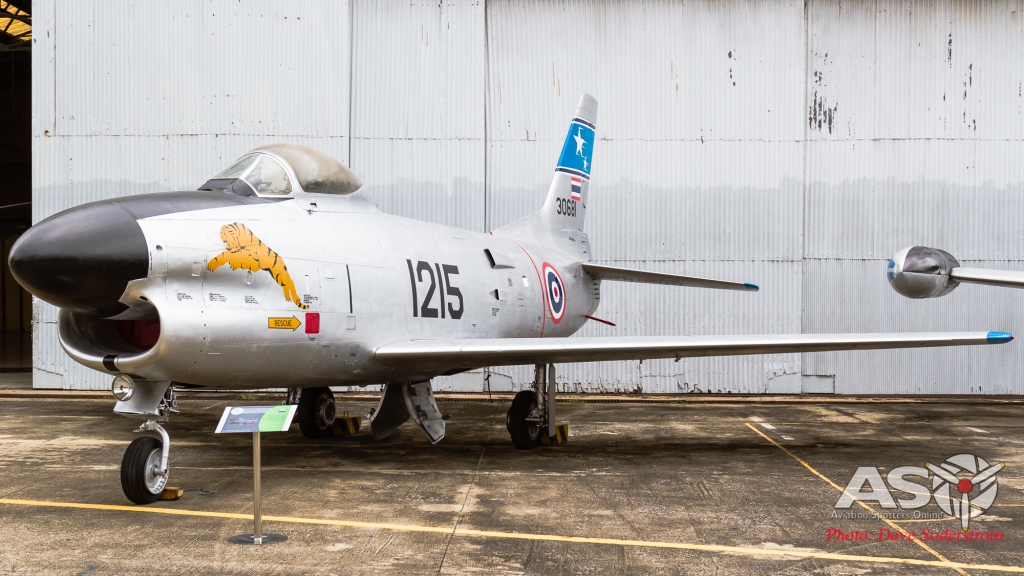

Boeing 737-200
The Boeing 737-200 is part of the most successful jet airliner family in history. The prototype first flew in 737-100 form in 1967. 30 of the 100 series were built before production turned to the 200 series. 1114 being produced at Boeing Field Renton. The RTAF ordered one 737-2Z6 being delivered in December 1983. The aircraft 22-222 flew as part of the VIP fleet until 2006. The aircraft was used for many overseas visits by the Thai Royal Family.




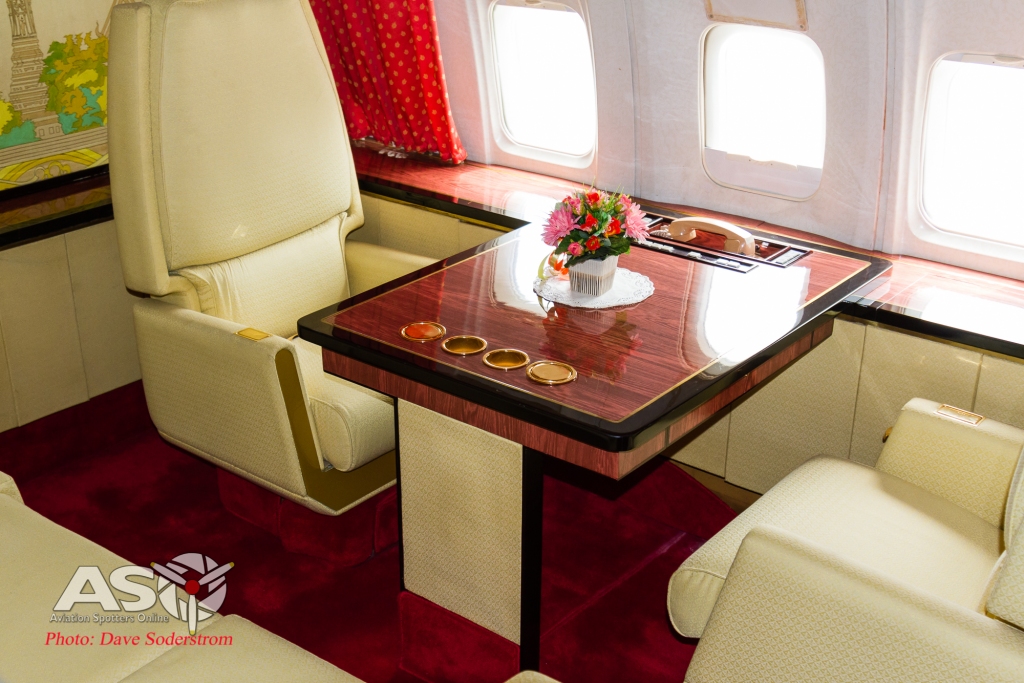
Percival Prince
Considering on one example of the type was operated by the RTAF the fact this aircraft survives is very remarkable. Percival P.54 Survey Prince 3A, was built and registered as G-AMNT and operated by Aerial Mapping Organisation with serial PhThOr. AMO was absorbed by the Army Mapping Department in 1954, it was soon transferred to the RTAF in 1955 which continued to operate it until being withdrawn in 1960. 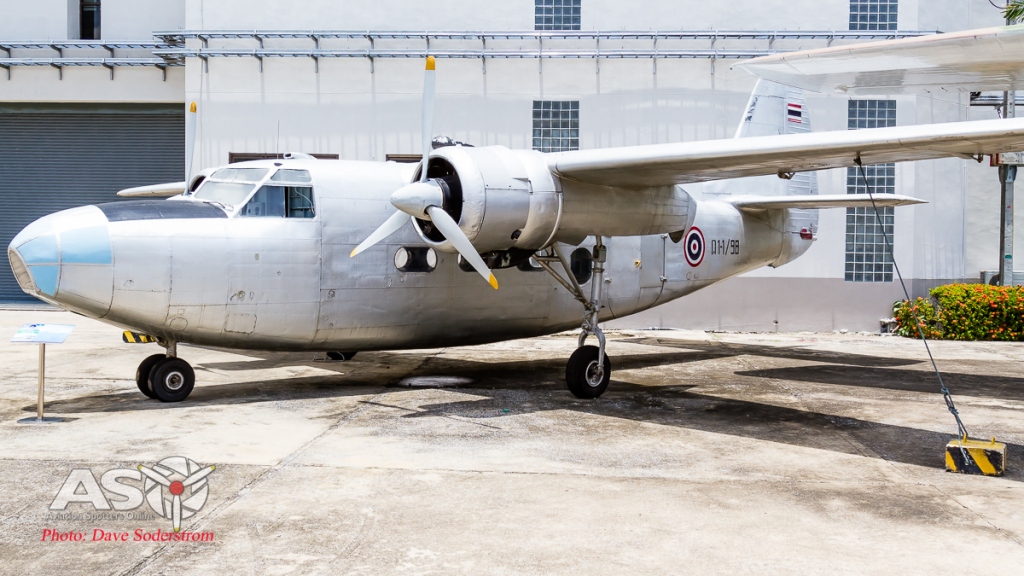
Beech C45
This twin engined light transport, was one of 7 delivered to the RTAF. Entering service in 1947 with many coming from RAF stocks. Both the C-45B and F version operated until 1971 when they were withdrawn from service.
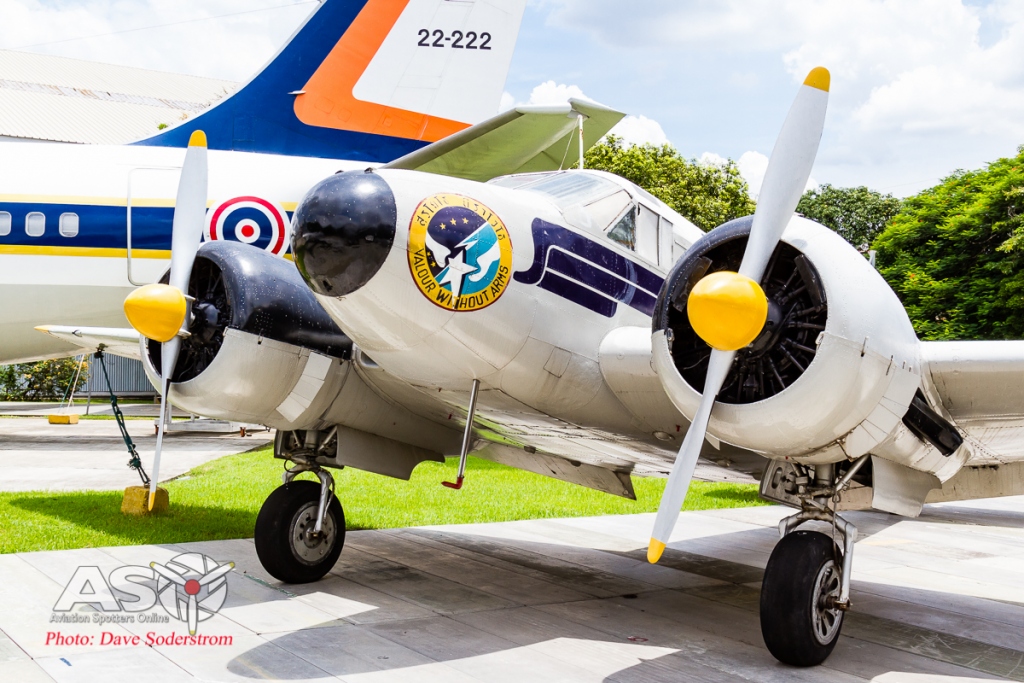
Beech C-45 BL1-6-90, Ex USAF 44-87152 and civilianised as HS-TBE.

Beech C-45 BL1-6-90, Beech C-45 Ex USAF 44-87152 and civilianised as HS-TBE.
Swearingen Merlin 4A
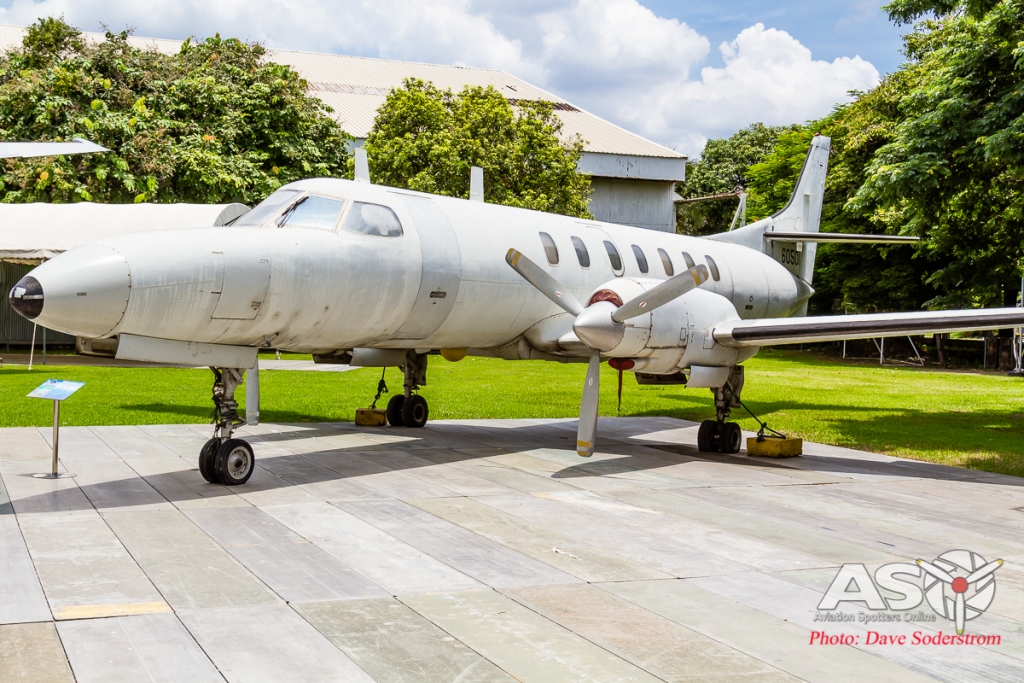
Douglas A-1H Skyraider
The RTAF never operated the Douglas Skyraider however the type was operated in Thailand during the Vietnam War. This particular airframe was left behind by the USAF after a wheels up landing in 1968. A comprehensive detailed timeline of this particular Skyraider is as follows. ex US Navy Bu142072, accepted by USN 28Jan57 at El Segundo in 1958 assigned to Carrier deployment to the western Pacific on USS Hancock. By 1960, it was on Carrier deployment to the western Pacific on USS Midway. By 1967 it was operated by VA152 ‘Wild Aces’ on Carrier deployment to the western Pacific on USS Oriskany. Its final flight which caused the wheels up landing was when it was hit by two 12.7mm rounds in the right wing over northern Laos on 27th December 1968. The aircraft was donated to RTAF Museum by General Harry C.‘Heine’ Aderholt by 1979.
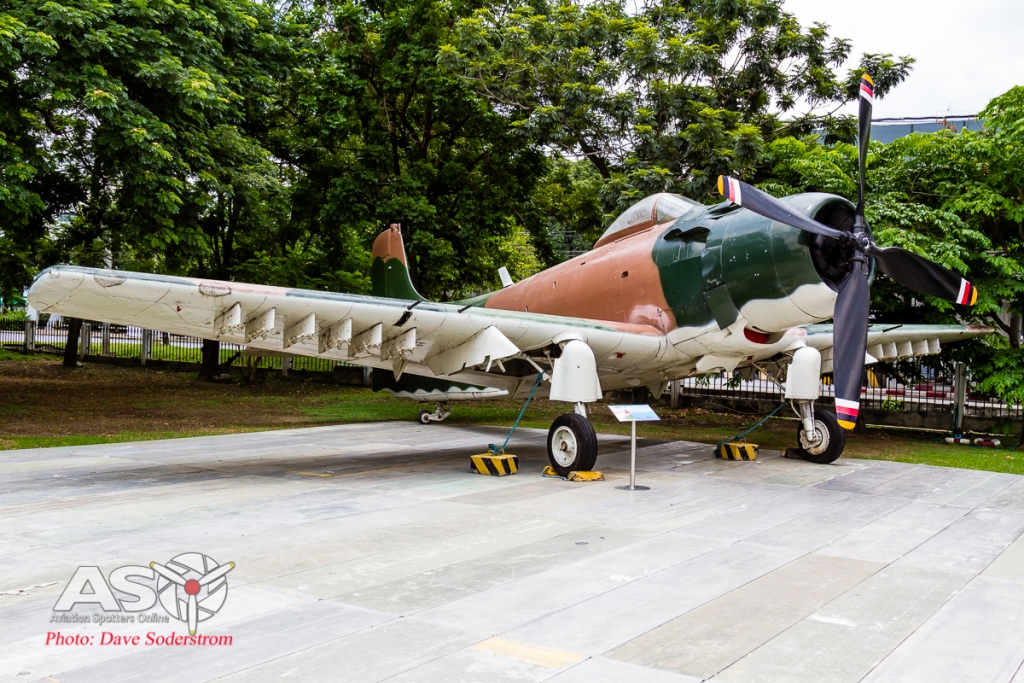
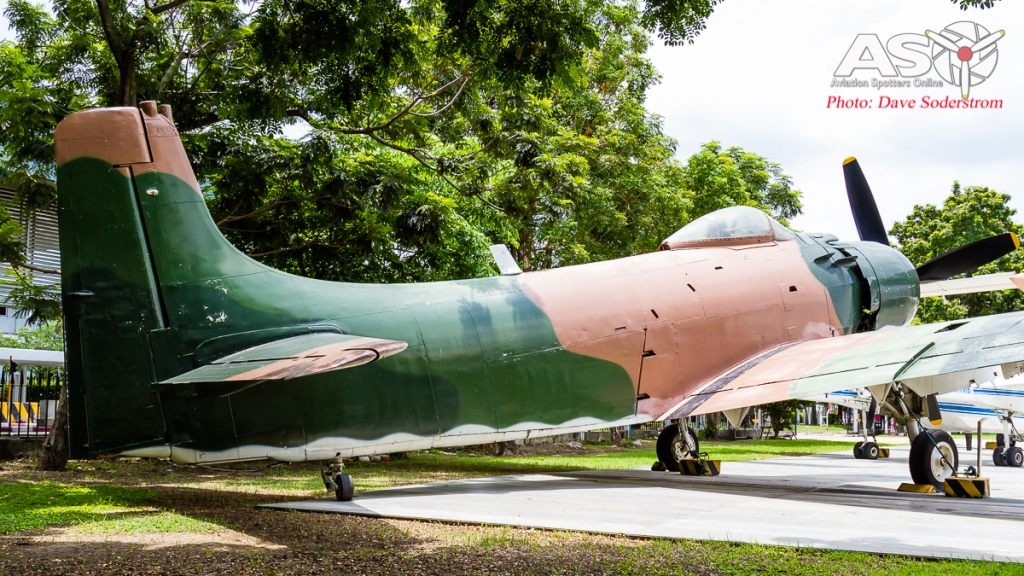
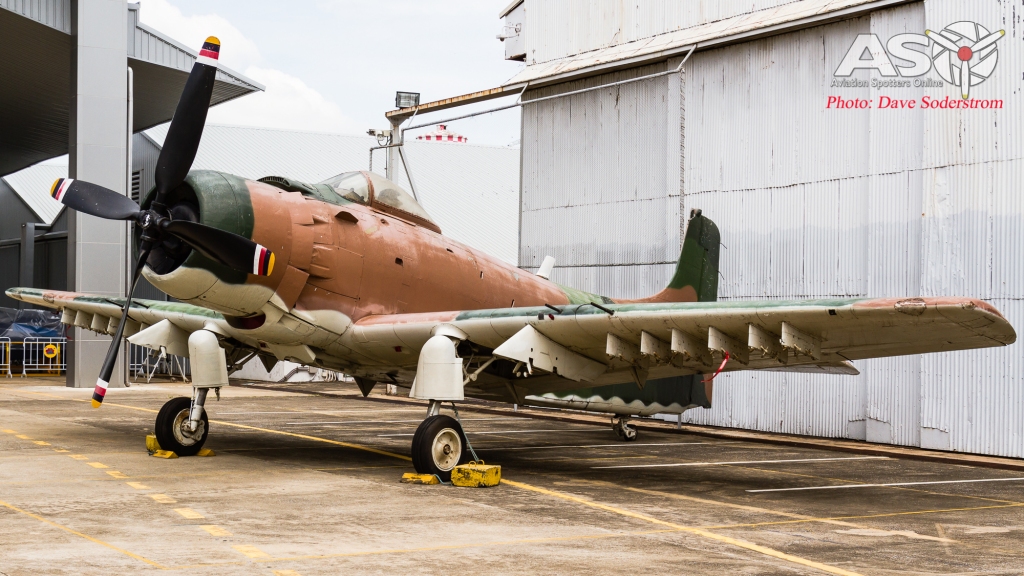
The aircraft was repositioned in mid 2017 for refurbishment
RTAF 5
The RTAF-5 was a Thai training and forward air control aircraft developed and built by the Science and Weapon Systems Development Centre of the Royal Thai Air Force in the 1980s. It was a twin-boom configuration aircraft powered by a single pusher turboprop engine, but only a single example was built. It joined the museum collection in 1994 and makes an interesting comparison to the OV-10 Bronco in front of it.
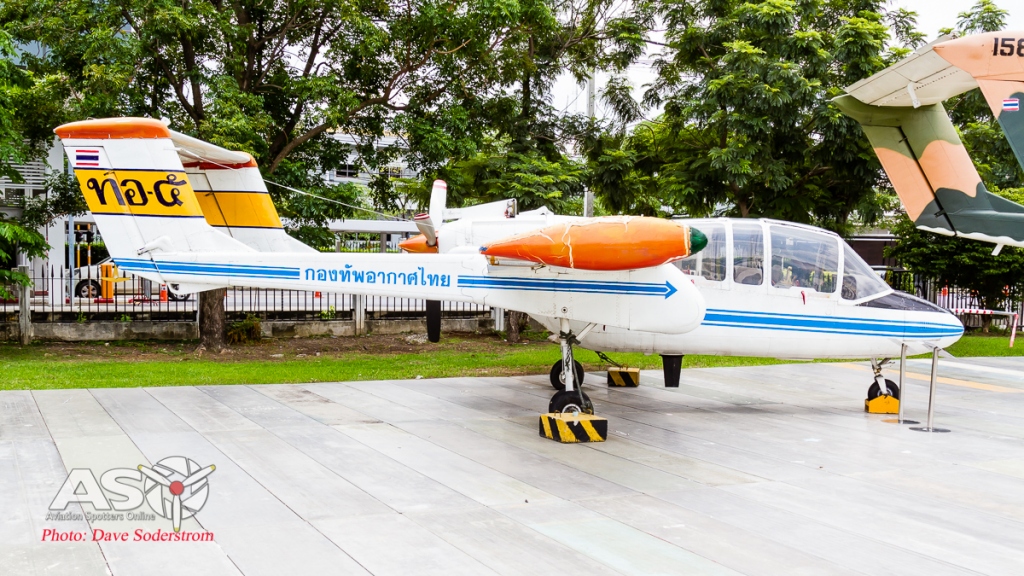
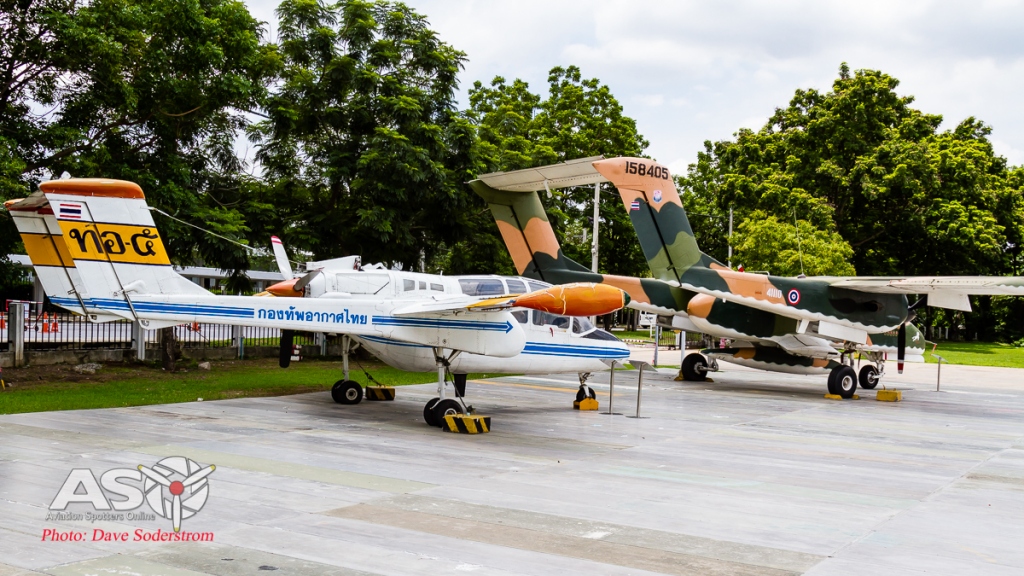
Rockwell OV-10 Bronco
Thirty two Rockwell OV-10 Bronco’s were delivered to the RTAF from 1972. The 1st batch of 16 was delivered on ‘USS Okinawa’ to Cam Ranh Bay, with the 2nd batch of 16 delivered by air across the Pacific by Skyways from 1973 through to 1974. The type was retired from service in 2004 and airframe 158405 joined the museum collection in 2004.


Beechcraft Bonanza
Three Beechcraft Bonanza’s were operated by the RTAF. Two coming from the Navy after the failed coup in 1951. One became the basis of the locally built RTAF.2.
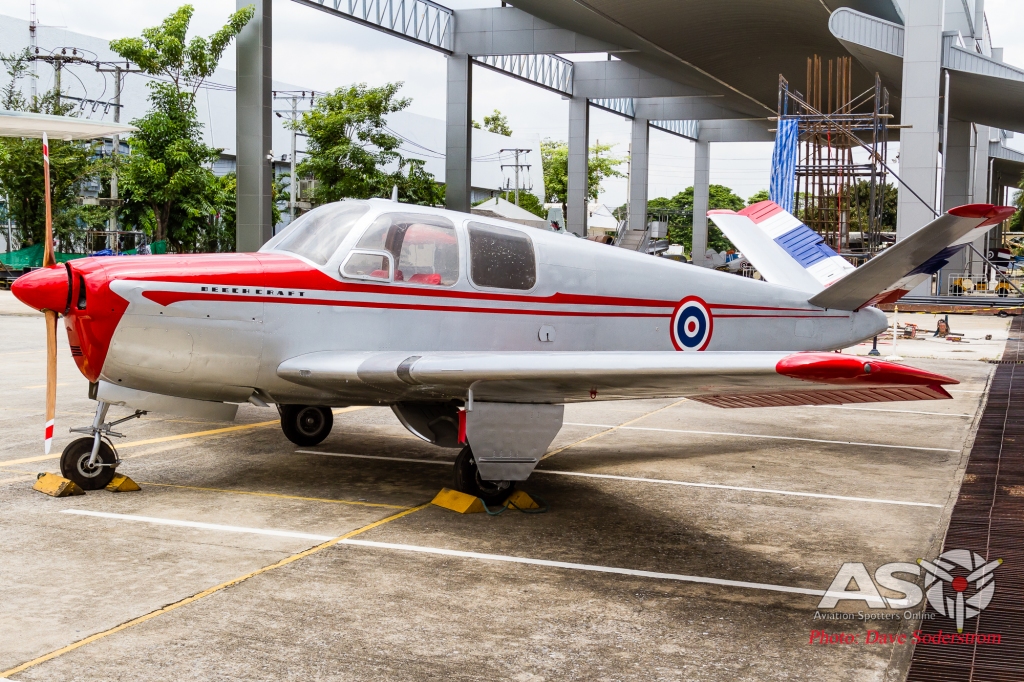
Helicopter Hangar
The Helicopter hangar has some well preserved examples of these workhorses of the RTAF. From the tiny Hiller H-12 Raven to the larger more modern Bell 212 and S-58.
Hiller UH-12B-4
This light utility helicopter, c/n 597, Entered service in 1953. One Hiller 360 was purchased in 1950 then followed by four UH-12B. H2k-4/96 is on display within the hall joining the collection in 1967.
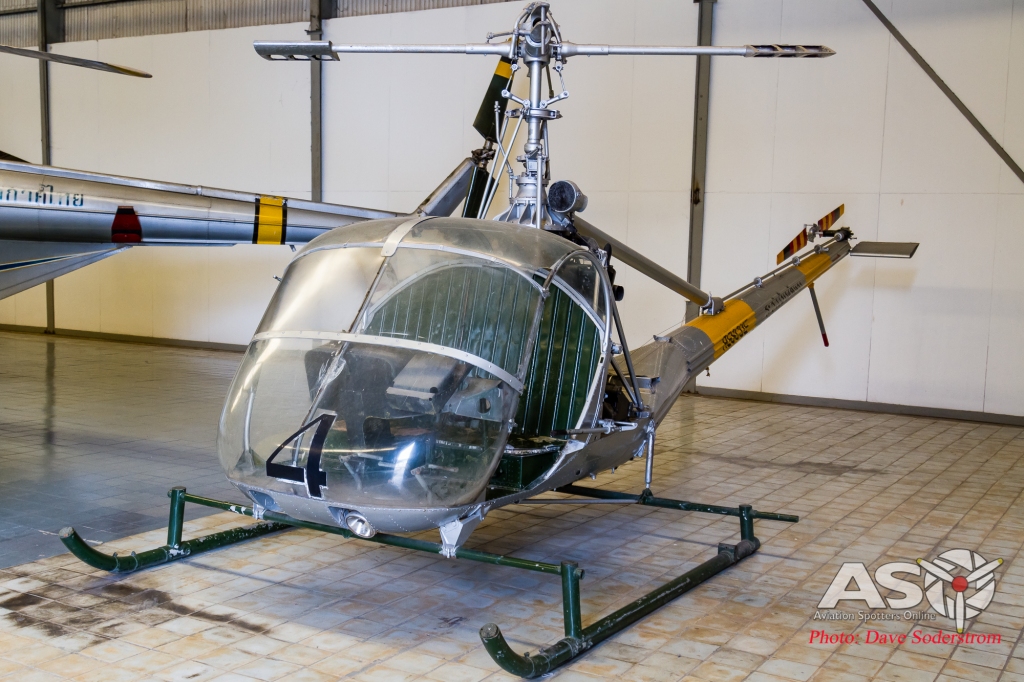
Sikorsky H-19A Chickasaw (S-55)
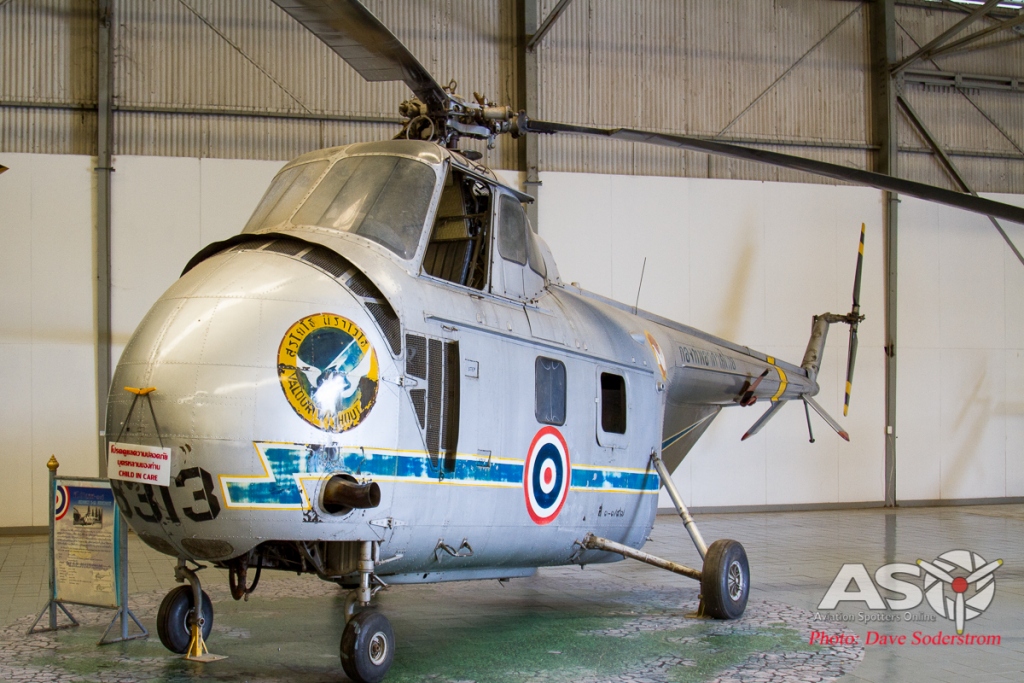
Bell UH-1N (212)
Two UH-1N Helicopters were delivered to the RTAF. Operated by the Royal Helicopter Flight the two were delivered in 1976. The example on display is H6k-1/19, which joined the collection in 2001.
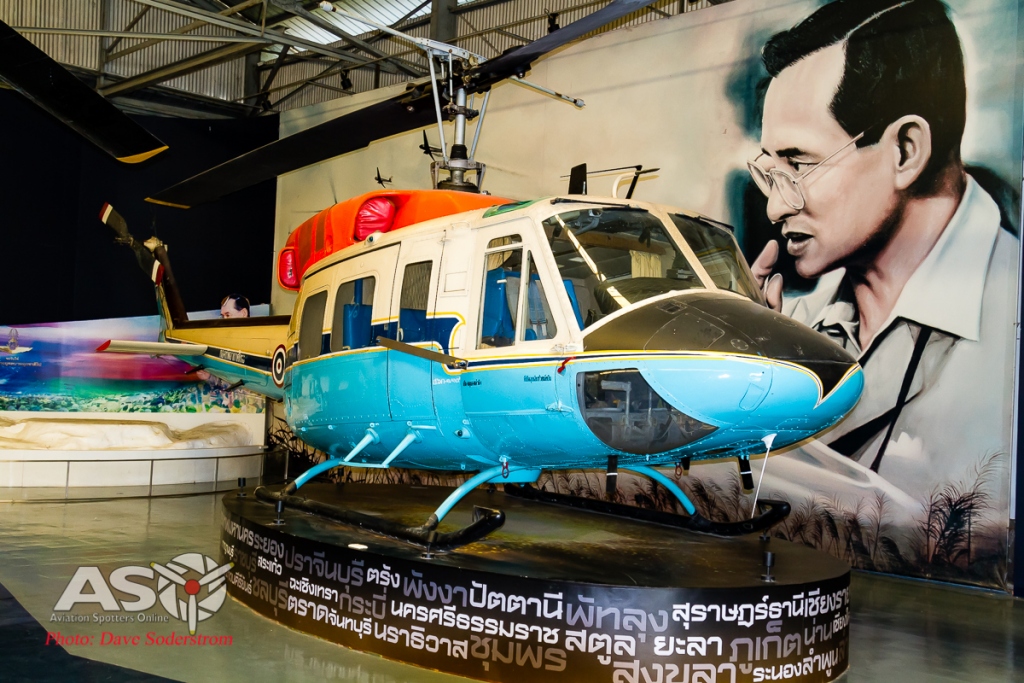
Bell OH-13A Sioux & Kaman H-43-B Huskie
Kaman Huskie H.5-2 / 05 , is one of four examples that served from 1963 to 1994. The Bell OH-13A, is one of the nine Sioux purchased by the Royal Thai Air Force in the years 1972-1973. The aircraft on display is an ex Thai Army example H7-9-15 2182.
Kawasaki KH-4
The Kawasaki KH-4 was a light utility helicopter produced in Japan in the 1960s as a development of the Bell 47 that Kawasaki had been building under licence since 1952. The most visible difference between the KH-4 and its forerunner was its new and enlarged cabin. This was fully enclosed (although the side doors were removable) and provided seating for three passengers side-by-side on a bench seat behind the pilot’s seat. The helicopter was provided with a new control system, revised instrumentation, and larger fuel tank.
A total of 211 KH-4s were built, including four that were modified from existing Bell 47Gs. The vast majority of these were bought by civil operators, although some were purchased by the military forces of Japan and Thailand. Six of these Helicopters were originally delivered to the Thai Army in 1964, at least one if not all six were later transferred to the RTAF. On display is KH-4 2040.

Bell 206B
The RTAF ordered six Bell 206B’s which were delivered from 1995. They were were acquired for training purposes. These Jet Rangers were used by the 3rd FTS in Kamphaeng Saen until 2007. Preserved at the RTAF museum is H8-01/38/‘01
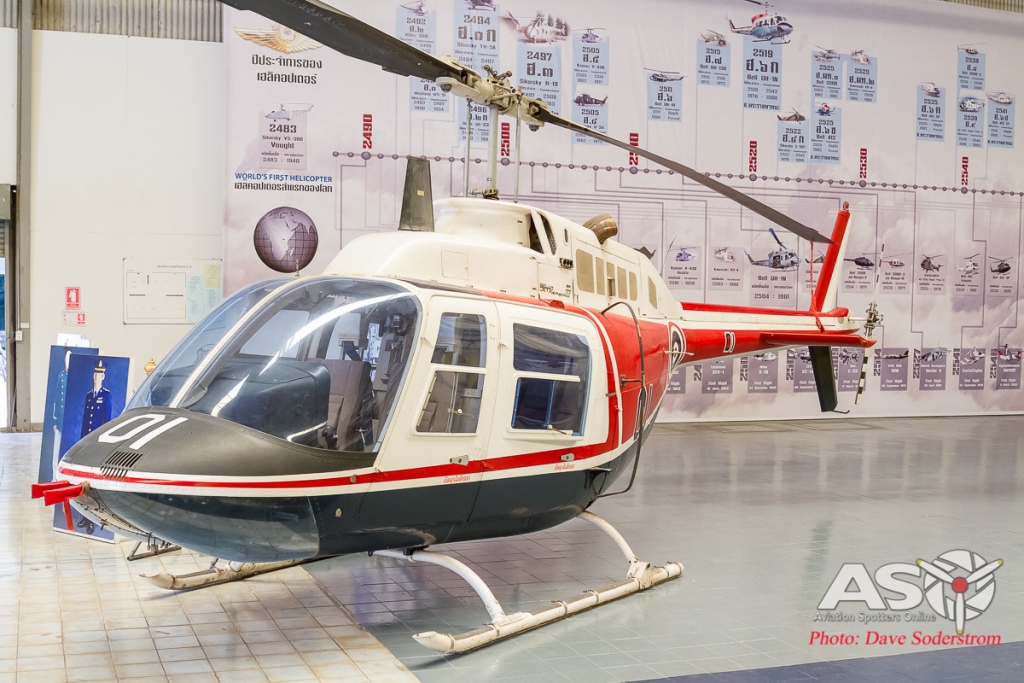
Bell 206B Jet Ranger
Sikorsky UH-34
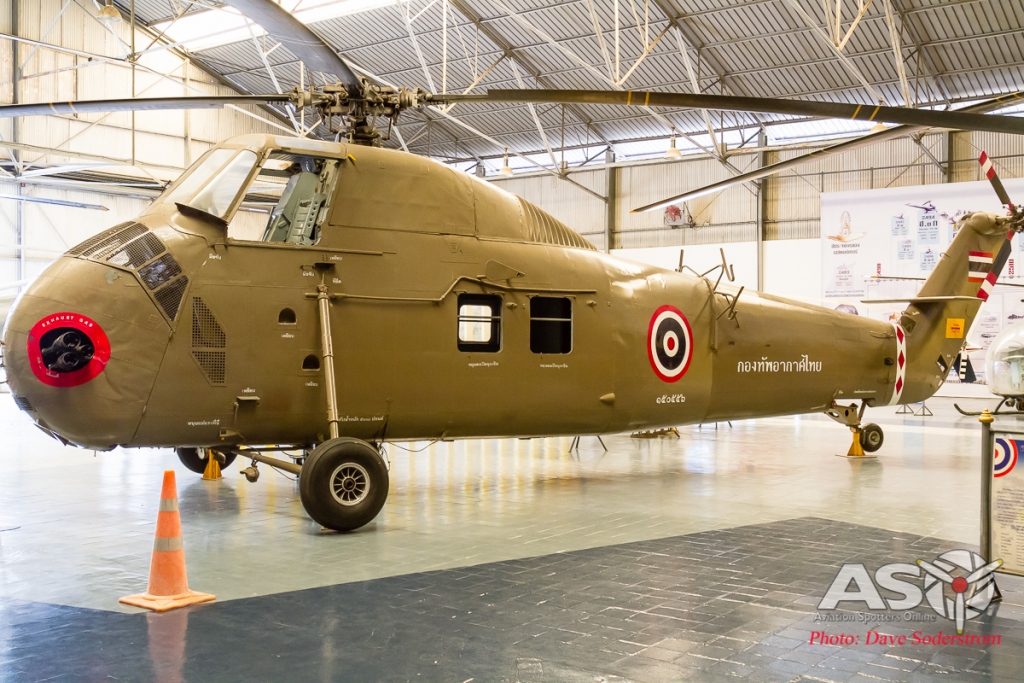
Sikorsky S-58T
Nineteen UH-34s were converted to S-58T standard in 1977 where they continued to serve with 201 Squadron 2 Wing until being withdrawn in 2003. On display is H4k-64/30/ 20117.
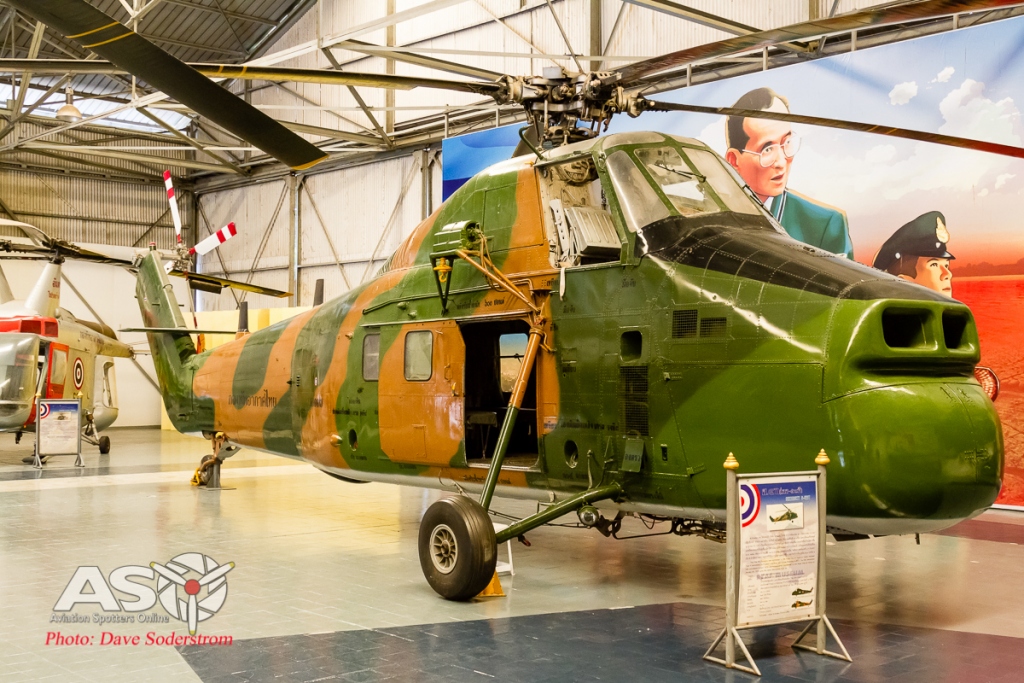
Sikorsky YH-5A
Operated along side its British cousin the Westland Dragonfly was the Sikorsky YH-5A. It joined the RTAF in 1953 however it too was also retired in 1954 after poor performance and no skilled maintenance crews to work on the aircraft. The aircraft on display is H1k-1/96.
Westland WS-51A Dragonfly
The first helicopter for the RTAF was the Westland Dragonfly. Although new to the RTAF they were already on their second and third owners by the time they went into service in 1950. While they were revolutionary the type suffered poor performance in the hot tropical environment in South East Asia. There service was short lived and were retired by 1954. On display is the sole surviving example, the former G-AMJW which became H.1-4/96 in RTAF service.
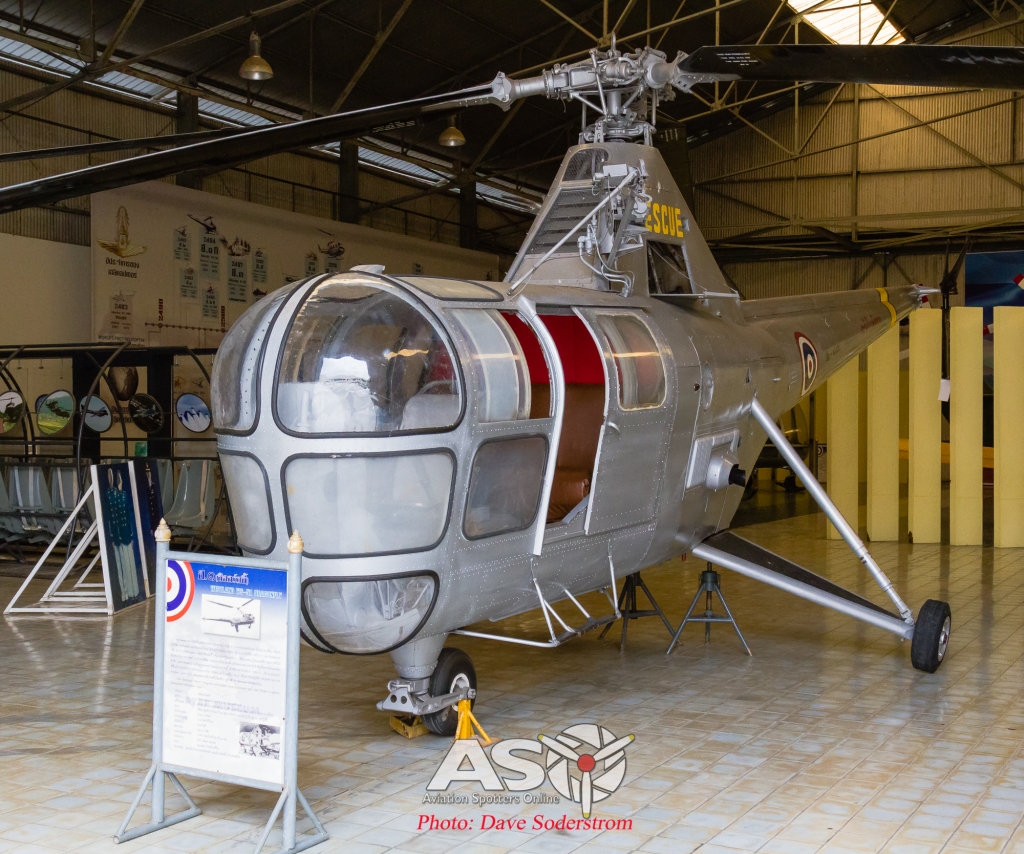
Tachikawa Ki-55 ‘Ida’
One of the rarest types on display and globally is this magnificent Ki-55 codename ‘Ida’ to the allies. This is one of only three Ki-36/55s left in the world. This aircraft is one of 24 delivered to the RTAF in 1942 and was retired from service in 1950.
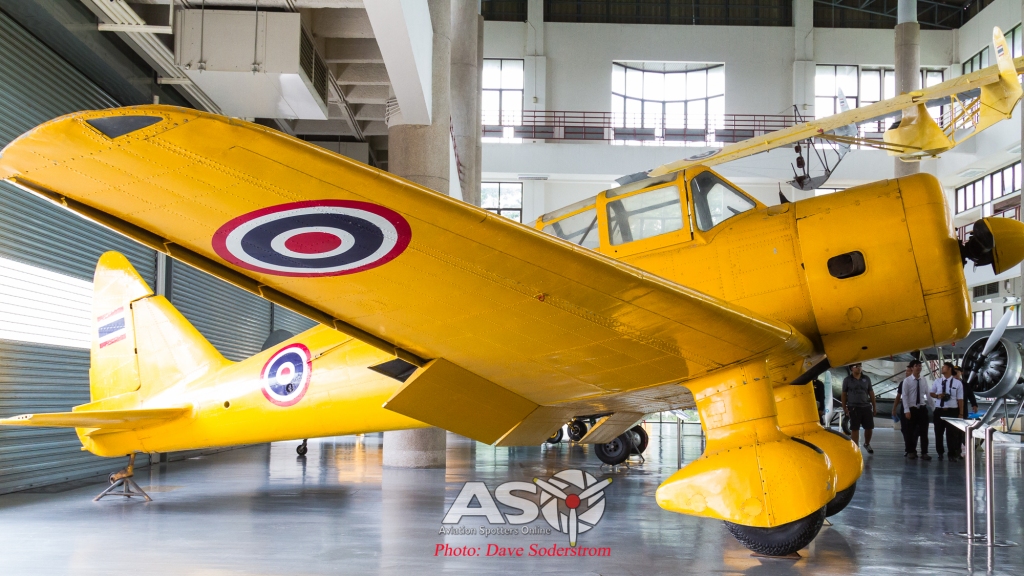
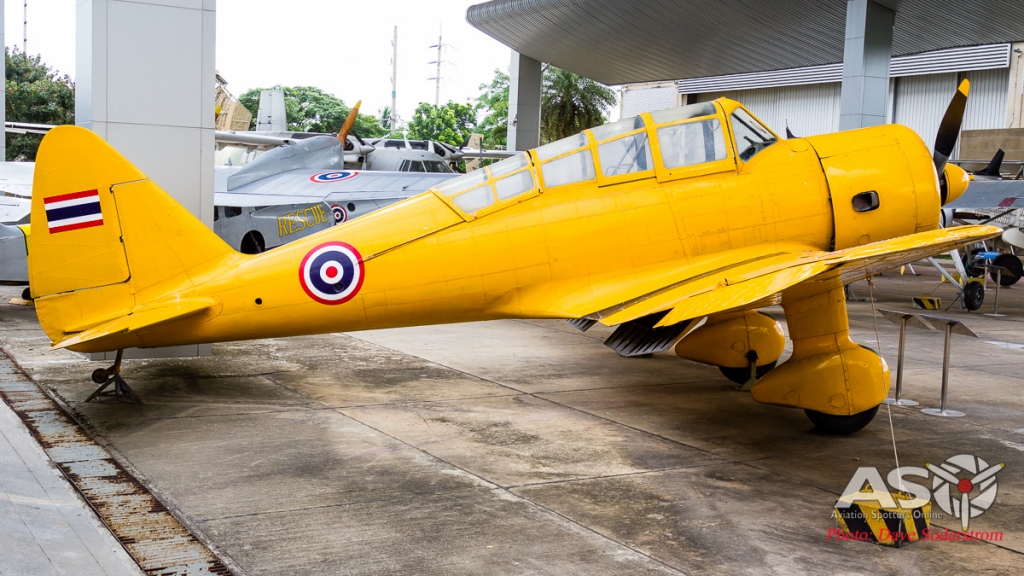
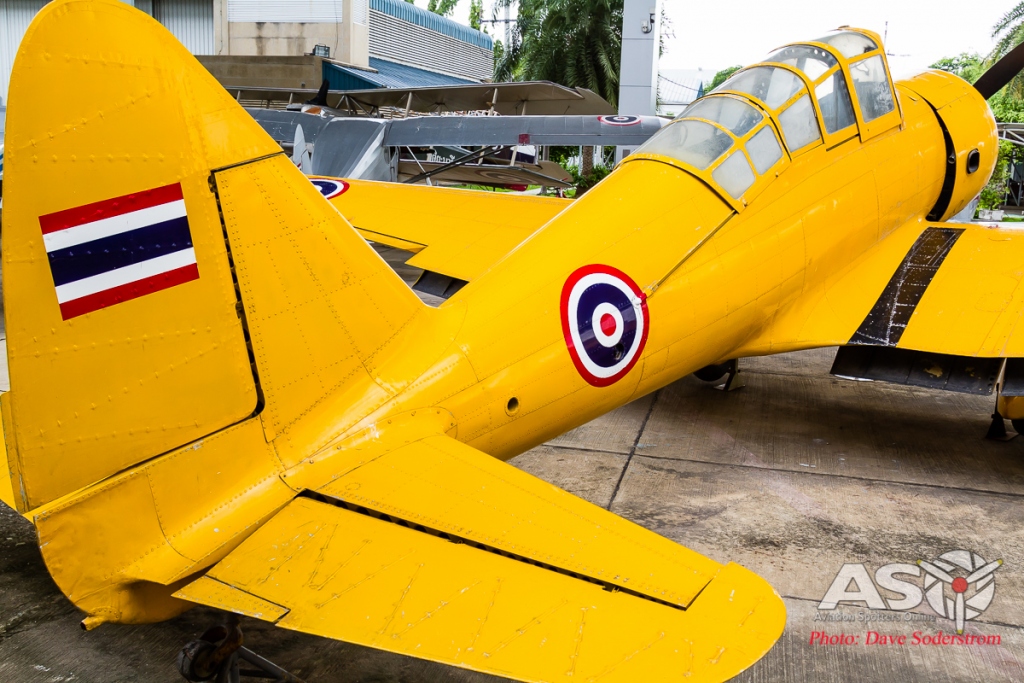

IAI Arava 201
Three Israeli built Arava’s were delivered to the RTAF in 1981 to be used by 402 Squadron based as part of Wing 4 in Nakhon Sawan. The three aircraft were used patrol aircraft and have now been replaced by UAV’s. Their retirement came in 2015 which saw airframe, 40204 become part of the museum.
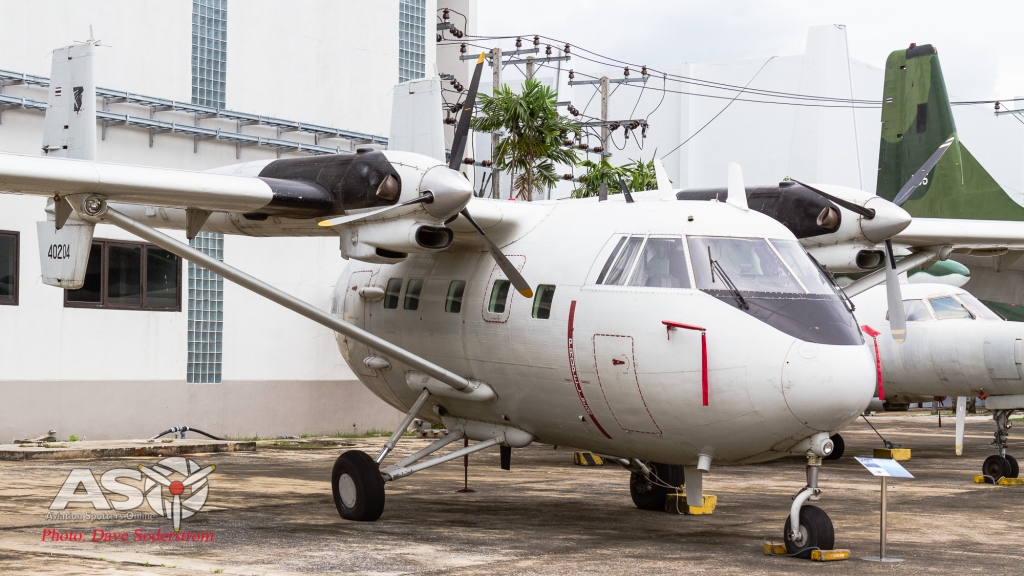

Fairchild C-123B Provider
The RTAF took delivery of over 48 Fairchild C-123 Providers. Deliveries commenced in 1964, in both C-123B and C-123K versions. All came from the USAF, some were flown during the Vietnam War on various missions. The type was well suited to the cargo role and the crews enjoyed fling the Provider. So popular was the type that the RTAF enlisted an American company, Mancro Aircraft Company of Paramount, CA and Dallas,TX to acquire a C-123 (56-4357) from the USAF stocks at Davis-Monthan, and re-engine it with T-56 turbo props. The now C-123T Provider first flew from Compton in 1980 and testing quickly discovered the aircraft wasn’t as good as hoped. The RTAF also realised it wasn’t cost-effective, and C-130’s were bought instead. The type was fully retired in the 1992. Aircraft, 555/ “L4-6/07” joined the RTAF Museum in 1983.


Aeritalia G222
Six of these Italian transports were delivered to the RTAF from 1995. Flown by 603 Squadron which is part of 6 Wing which was based at Don Muang. The type was in service in limited numbers until its retirement in 2010 when the last flying example was retired. On display at the museum is 60312 which became part of the museum collection in 2009.
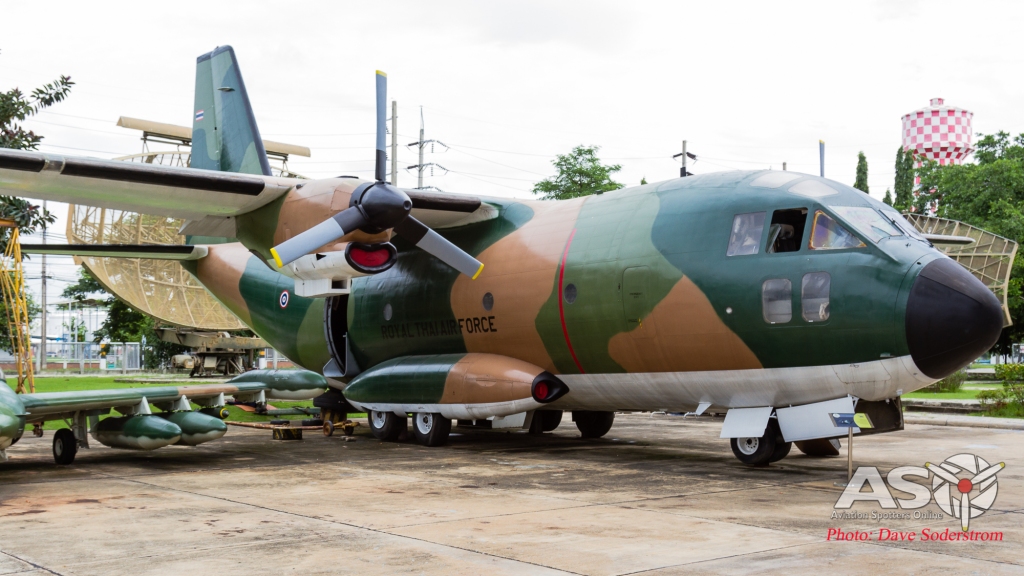
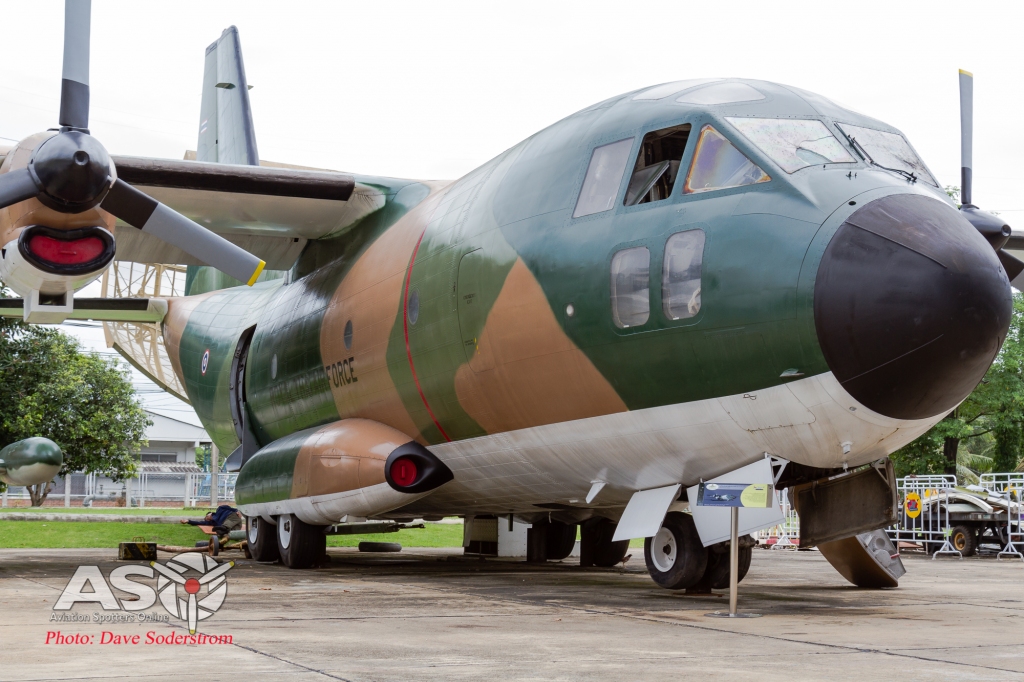
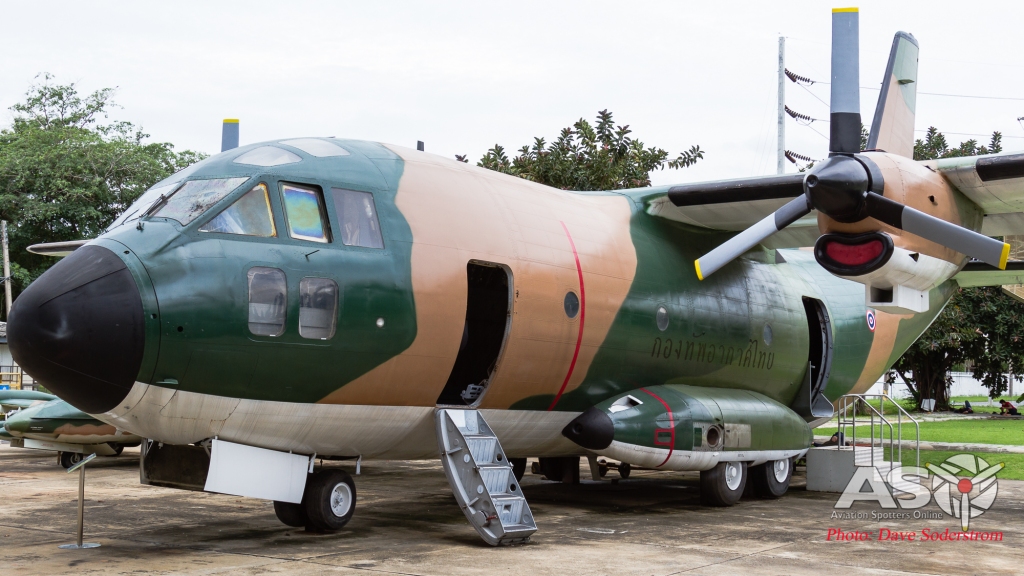
Cessna A-37B
Another Cessna A-37B Dragonfly is on display beside the G222. This aircraft is serialed 21133. It’s shows with a full wing load including drop tanks and bombs.
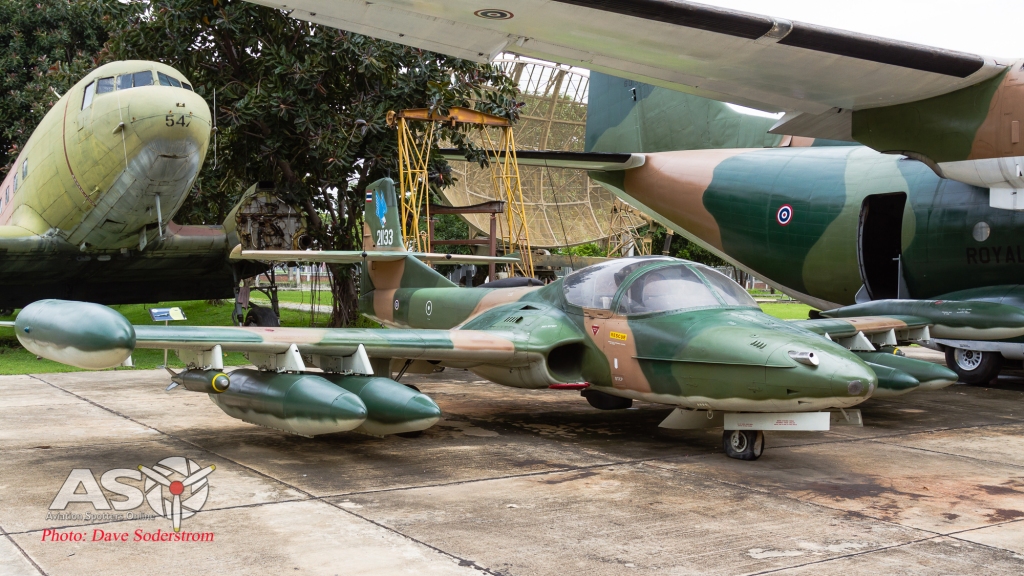
Douglas C-47 Dakota
It’s a prerequisite of any aviation museum to have an example of the Douglas C-47 isn’t it? The RTAF continues to operate the Dakota today in the much updated and modified Basler BT-67 turbo prop version. Some 45 examples have been delivered over the years coming from multiple sources, including Australia. Versions operated have included the C-47, AC-47 Gunship, VC-47, EC-47 and of course the BT-67 which continues in service where it has been used for roles such as Para dropping and even fire fighting. The airframe on display serialed 547 is a C-47A which is ex USAAF 42-100547. The Aircraft is complete with the wings and engines stored nearby. This aircraft is due to be refurbished and assembled for display in the near future.
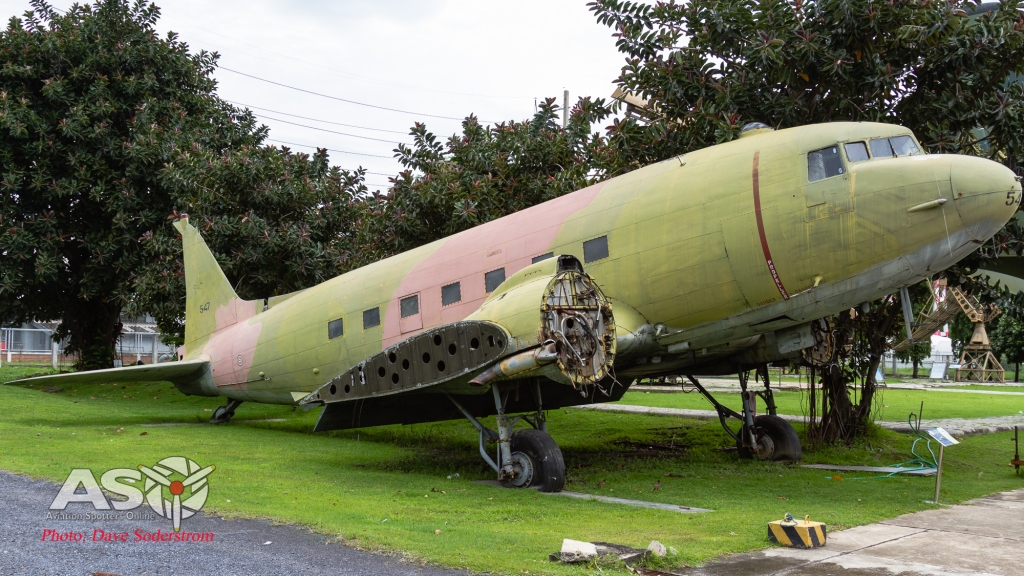
North American T-6 Texan
Another T-6G Texan is on display within the museum this example is ex 51-4666.

Stinson L-5B
Thirteen of these liaison and light transport aircraft were acquired in 1947 from the RAF in Burma. This example is an L-5B and was serialed S4-10/90 and is ex 44-6985, its RAF serial being KJ464.

RTAF Stinson L-5B
Piper L-4
Some forty two war surplus aircraft were supplied to the RTAF from the Allies in 1947. The last in service was retired in 1959. This example 4-S3-4/90 has been with the collection since 1967.
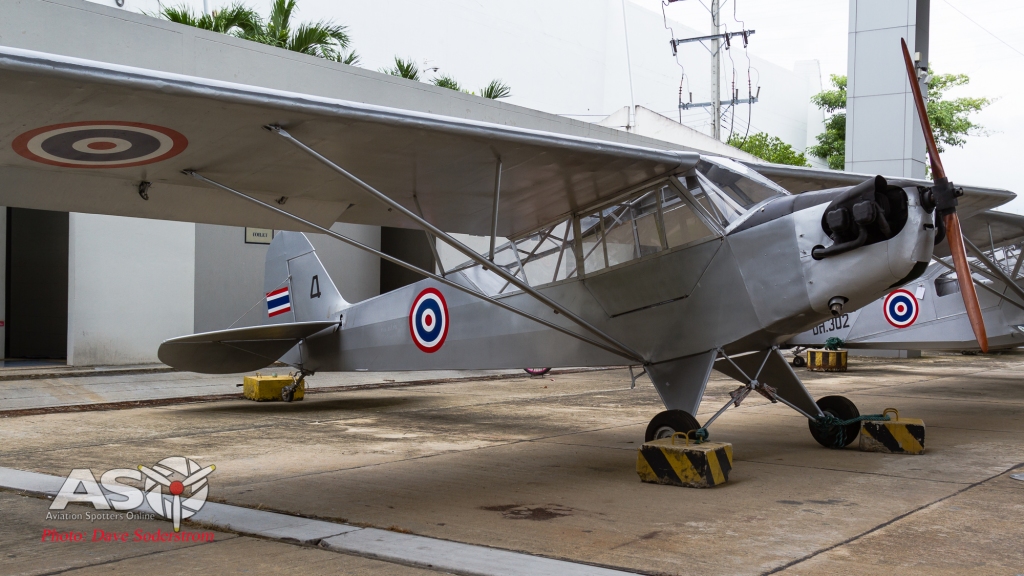
Piper L-4
Grumman G-44 Widgeon
Five Grumman Widgeon’s were operated by the RTAF. They were transferred from the Navy following failed Navy coup in 1951. The sole survivor is on display at the museum. 1449 has been in the museum since arriving in 1967.


ThOr6
Locally developed and built the ThOr6 is a development of the basic SIAI Marchetti SF-260. The new training aircraft was fitted with a 420-horsepower Turbo Prop Allison 250 engine, fitted with 3-blade propeller and a new engine mount and cowling. Its first flight was on June 14, 2012. Twenty five of the type are intended to be flown by 203 Squadron based at Don Muang. Two examples are at the museum. One was being installed within the new hall and one was yet to be unpacked from its transport crate.


Government Aircraft Factories N-22 Nomad
Designed and built in Australia by GAF the Nomad served both the RTAF and RTN. Twenty two examples were received by the RTAF from 1982. The Nomads or Missionmasters as they were marked as were ordered to replace the C-47s then in service. Locally designated as the BL.9 some were armed with 20mm cannon. Operated in RTAF service by 6075 and 461 Squadrons. Despite being retired by our own RAAF many years ago the Thai’s kept them going till retirement in 2015. On display is 46122 which was built and flown in Australia as VH-UVG.


Cockpit of Nomad 46122
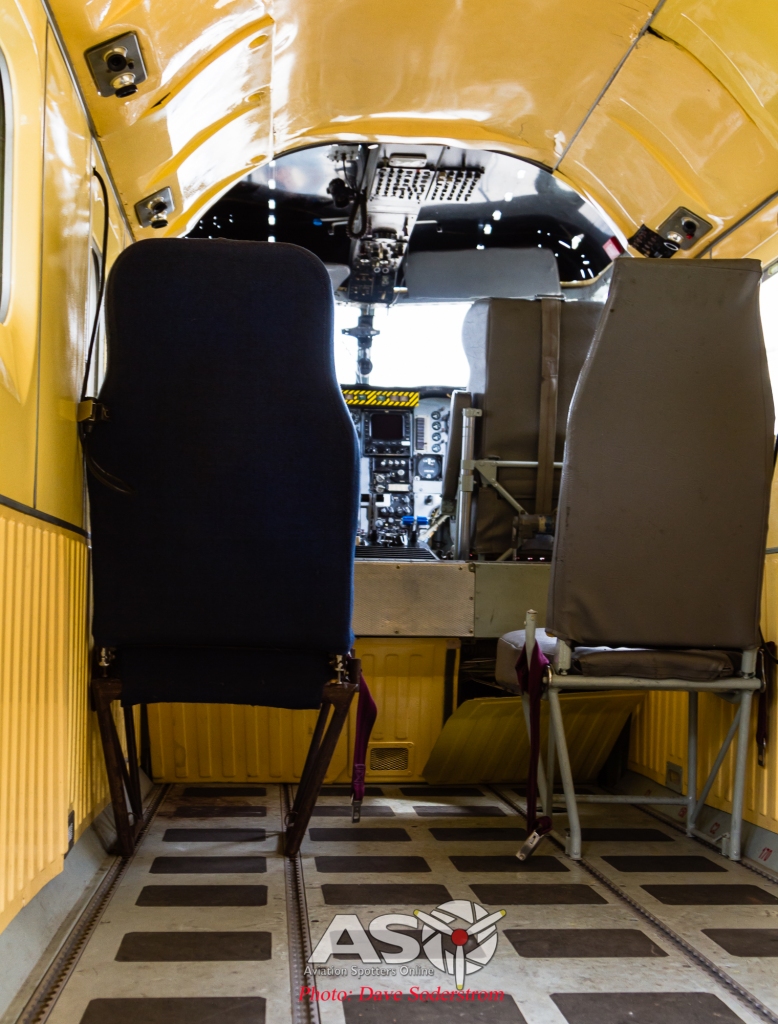
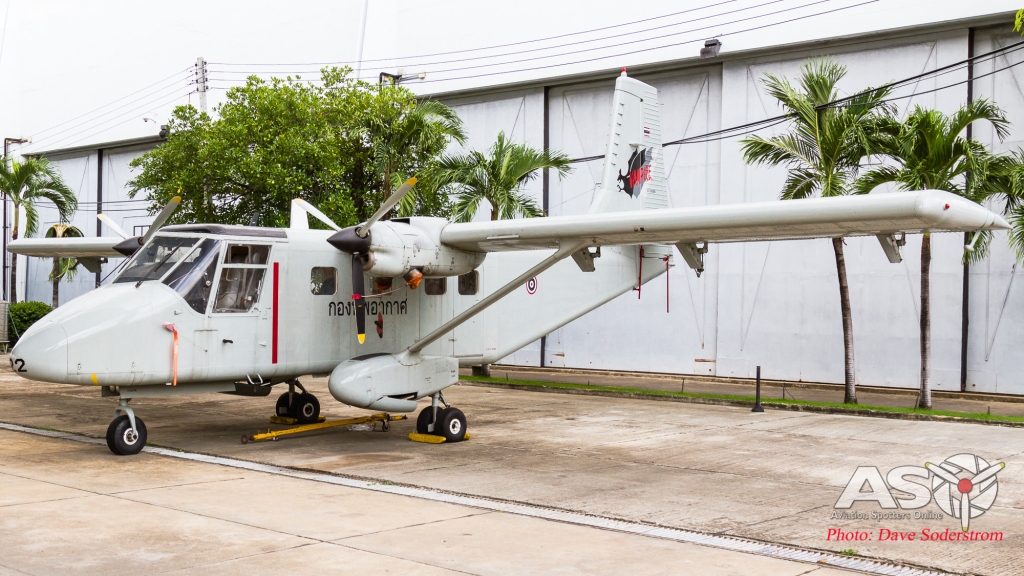
De Havilland DHC-1 Chipmunk.
The second example at the museum is painted in its Royal Thai Flying Club.
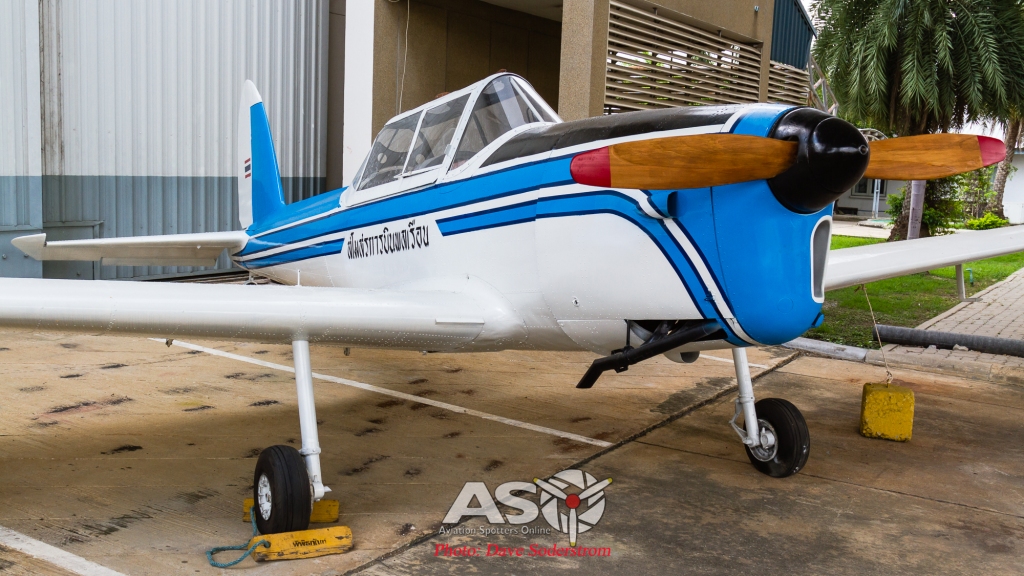
RTAF-2
The RTAF-2 was developed from the Fuji LM-1 Nikko, itself a derivative of the Beechcraft Bonanza. One prototype was built in 1957 and tested in 1957–58, although no further production followed. The aircraft joined the collection in 1984.
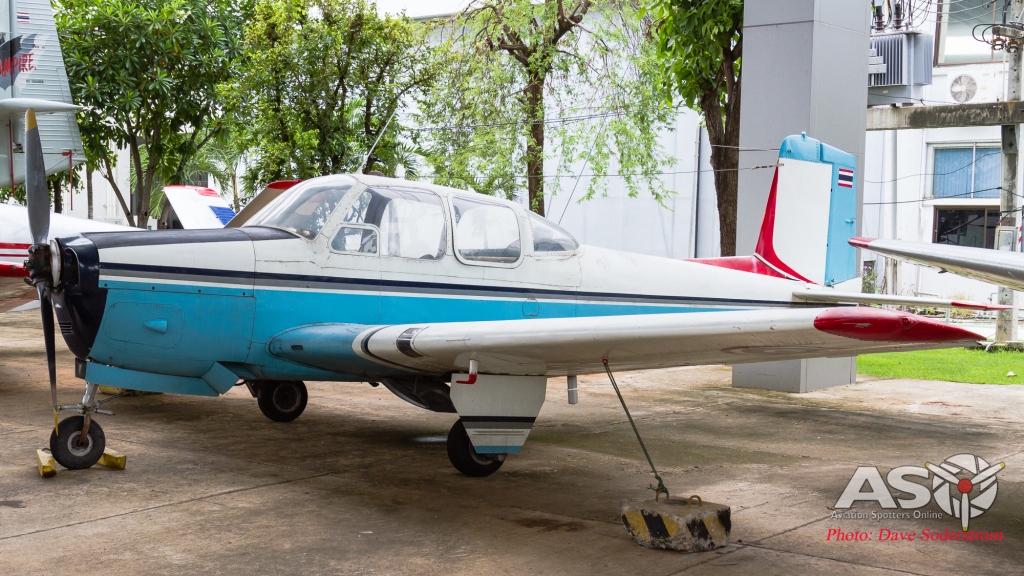
RTAF-2
RTAF-4
The RTAF-4 was developed from the de Havilland Canada DHC-1 Chipmunk that were used by the Royal Thai Air Force. Production began in February 1971 and the prototype made its first flight on 25 September 1972. The plane, with redesigned cockpit and tail sections, had a payload of 345 kg and its maximum gross weight for aerobatics was 1,044 kg. 12 aircraft were produced, that entered into service in 1974, four of which were used as trainers for the Civil Aviation Department of the Thai Air Force. Serial BF 03 is on display at the museum.
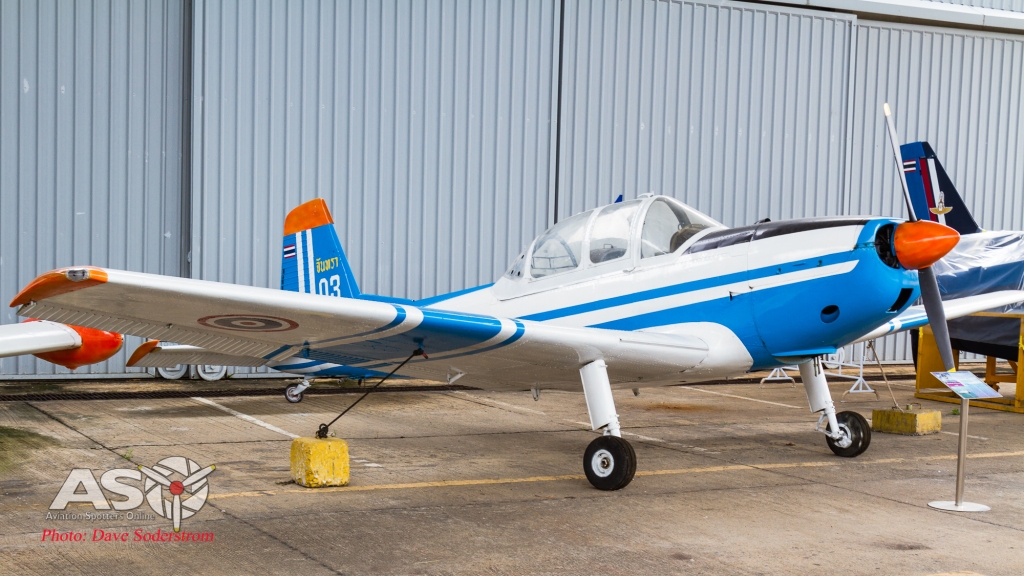
RFAT-4
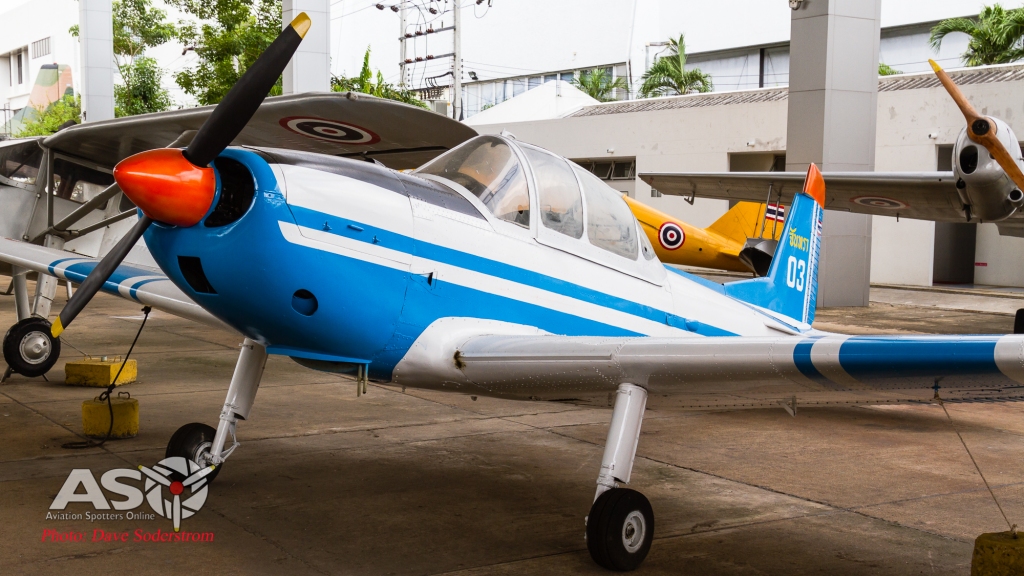
Supermarine Spitfire FR.14E
A real personal favourite of mine, the Supermarine Spitfire. The RTAF took twenty four Spitfire 14’s, plus 6 for spares use. These arrived in Thailand between February 1951 and January 1952. In 1954 three ex-FEAF Spitfire PR.19’s were delivered for instructional use, and a fourth went to Trat as an instructional airframe. The Spitfire was flown by 41 Squadron who continued to operate the type until its retirement in 1955. The Griffon engined version, was fitted with 2 × 20 mm Hispano Mk II cannon with 120 rounds-per-gun (rpg) in the outer bays combined with 2 × .50 cal Browning M2 machine guns, with 250 rpg in the inner bays. With of the relocation of the Hispano to the outer gun bay the blisters covering the feed motors were moved outboard on the gun bay doors. The airframe on display, Kh14-1/93 is ex RAF SM914. The aircraft is in true time capsule condition with all its equipment in place.
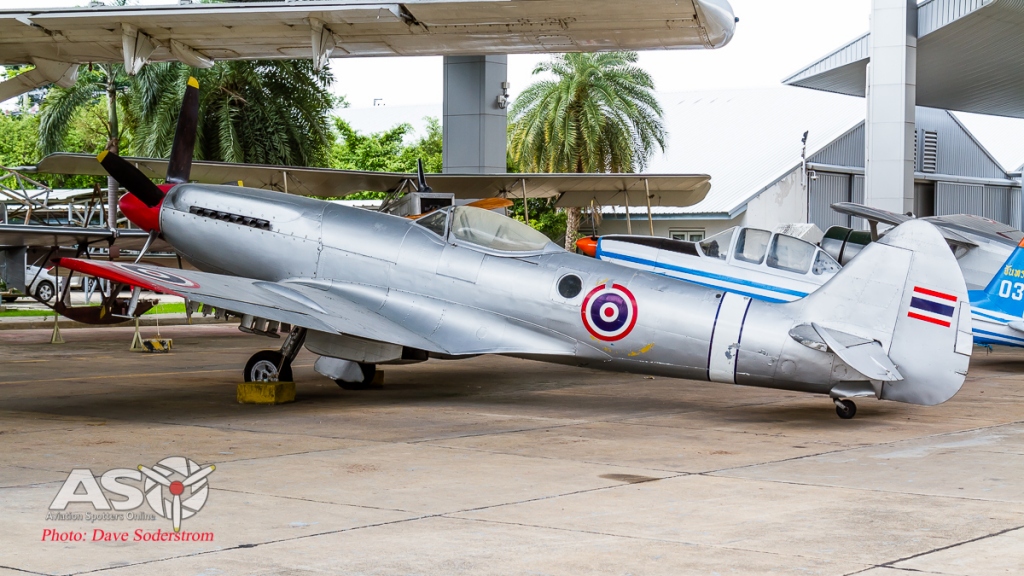
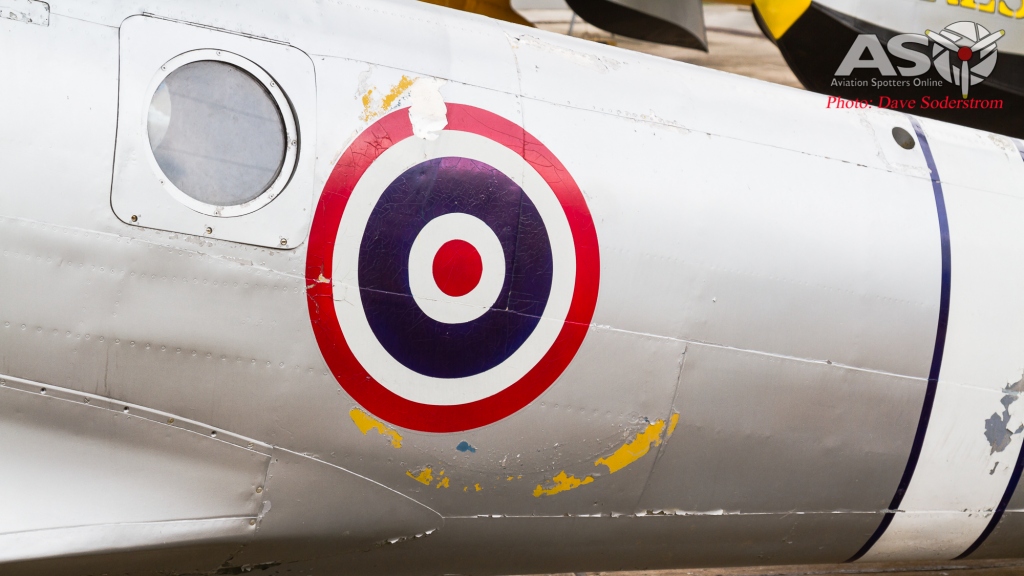
The aircraft shows its RAF linage with its RAF Roundel poking through.
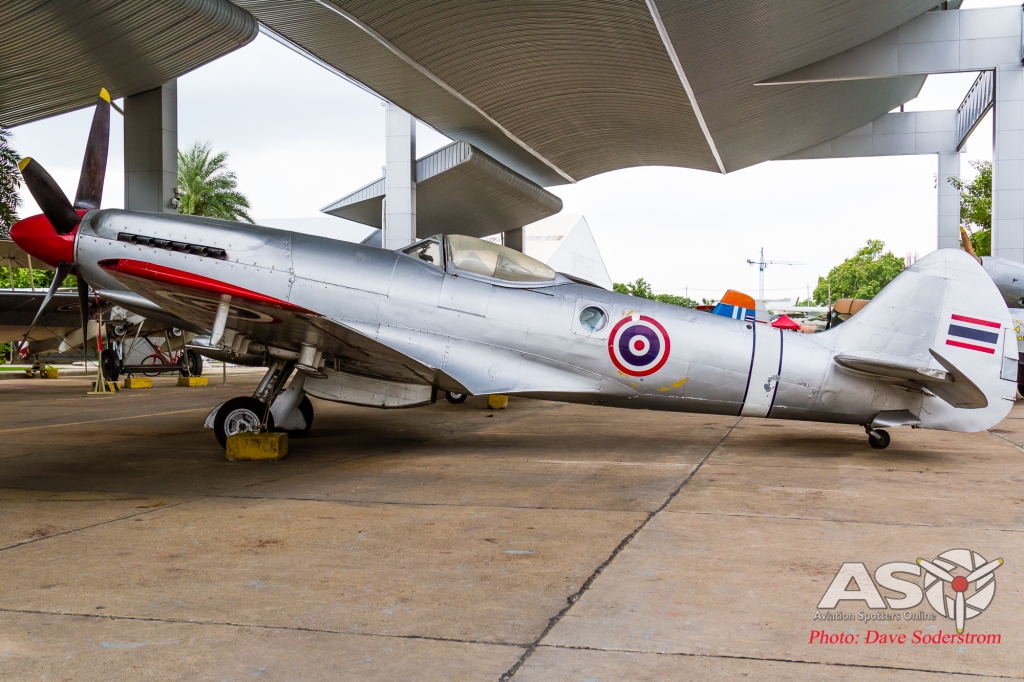
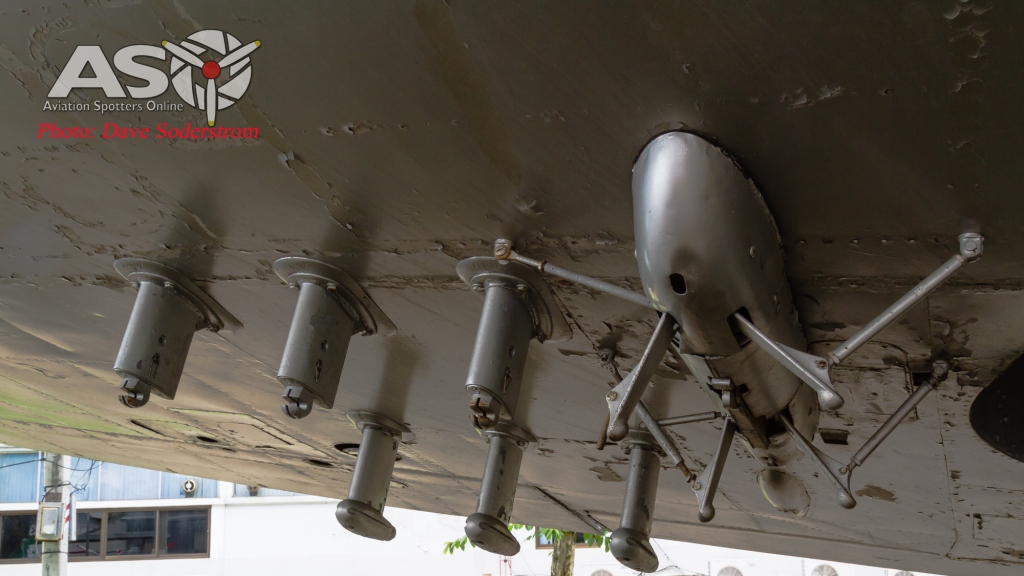
The Bomb and rocket racks are still in place

Vought A-7C Corsair
Eighteen A-7 Corsairs saw operational service with the Royal Thai Navy. Fourteen A-7E and four TA-7Cs flew with 104 Squadron. Supplied from ex US Navy stocks they started arriving in 1995. The type was operational until 200. Operated by No 104 Squadron, an example has recently arrived from its old base at U-Tapao in Southern Thailand. Ex US Navy Bu16056, became 1411 in RTN service.
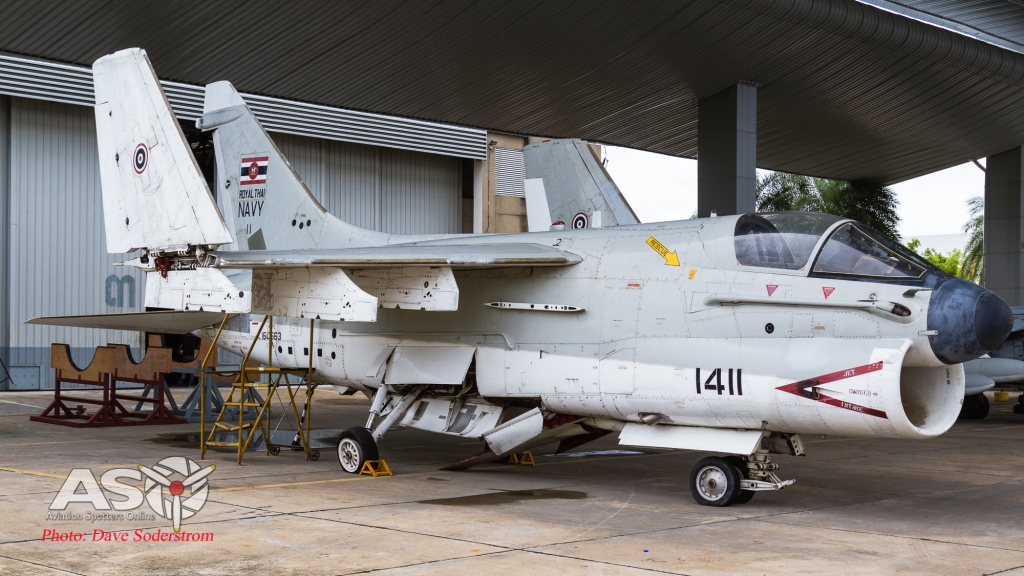
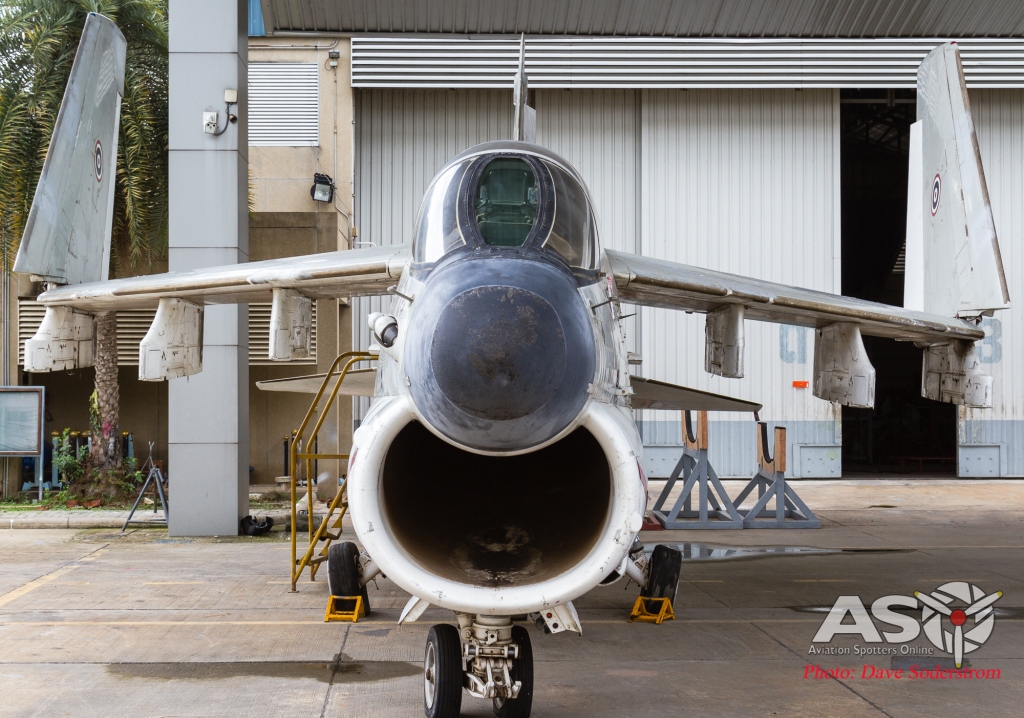
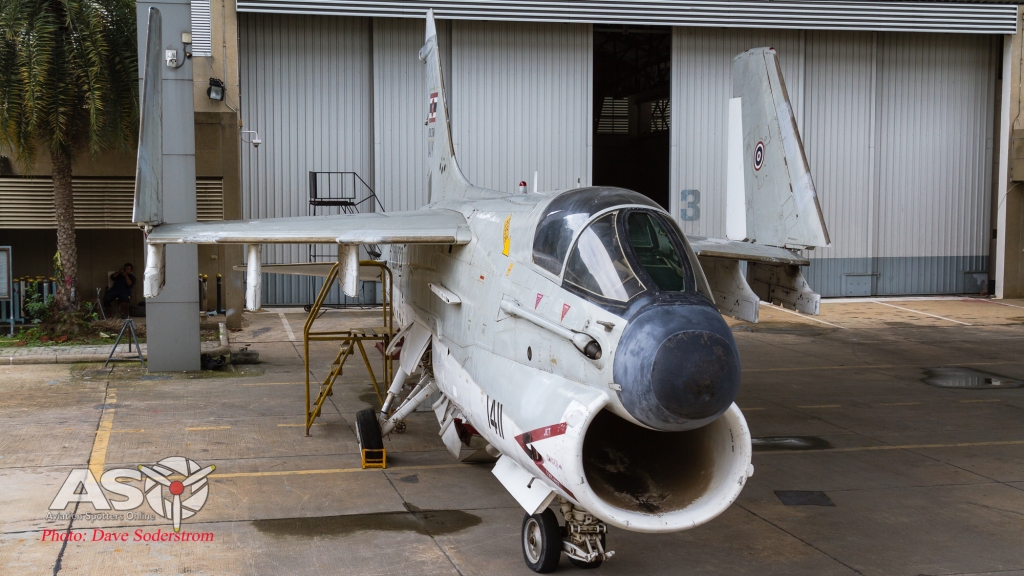
McDonnell Douglas AV-8A Harrier
Nine aircraft were sourced from the Spanish Navy in 1996, being delivered in 1997 on the aircraft carrier ‘RTNS Chakri Naruebe’. The aircraft were operated by 1 Squadron 3 Wing. Two TAV-8S and seven AV-8S were to see brief service until lack of spares saw the type withdrawn from service in 2006. Aircraft 3109 arrived in June 2017 along side the previously mentioned Corsair.

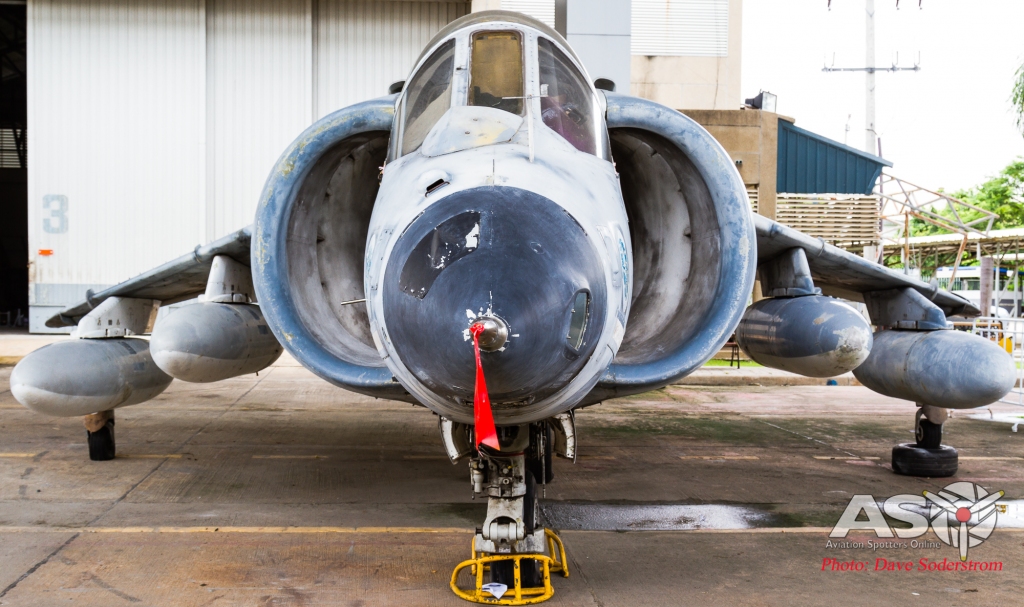



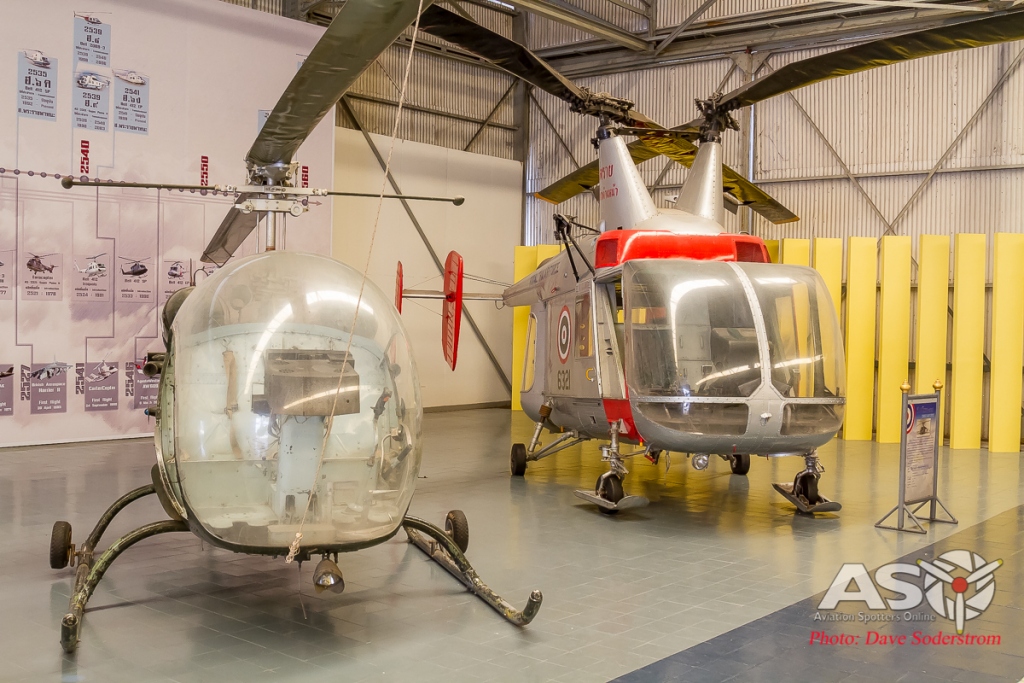


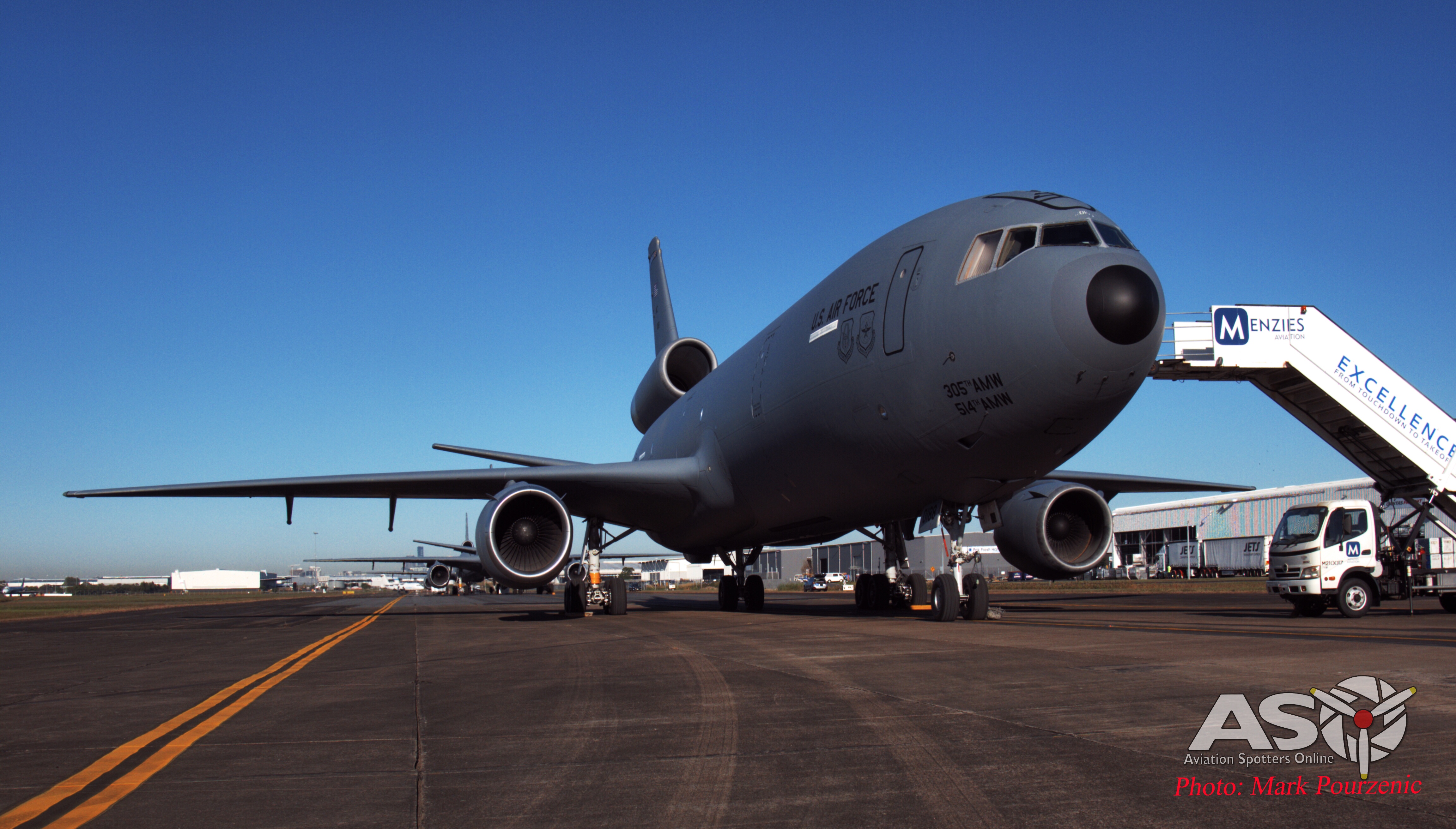





What a great collection – some real treasures amongst that lot! Fantastic that some real rarities have been preserved. Thanks for the write-up.